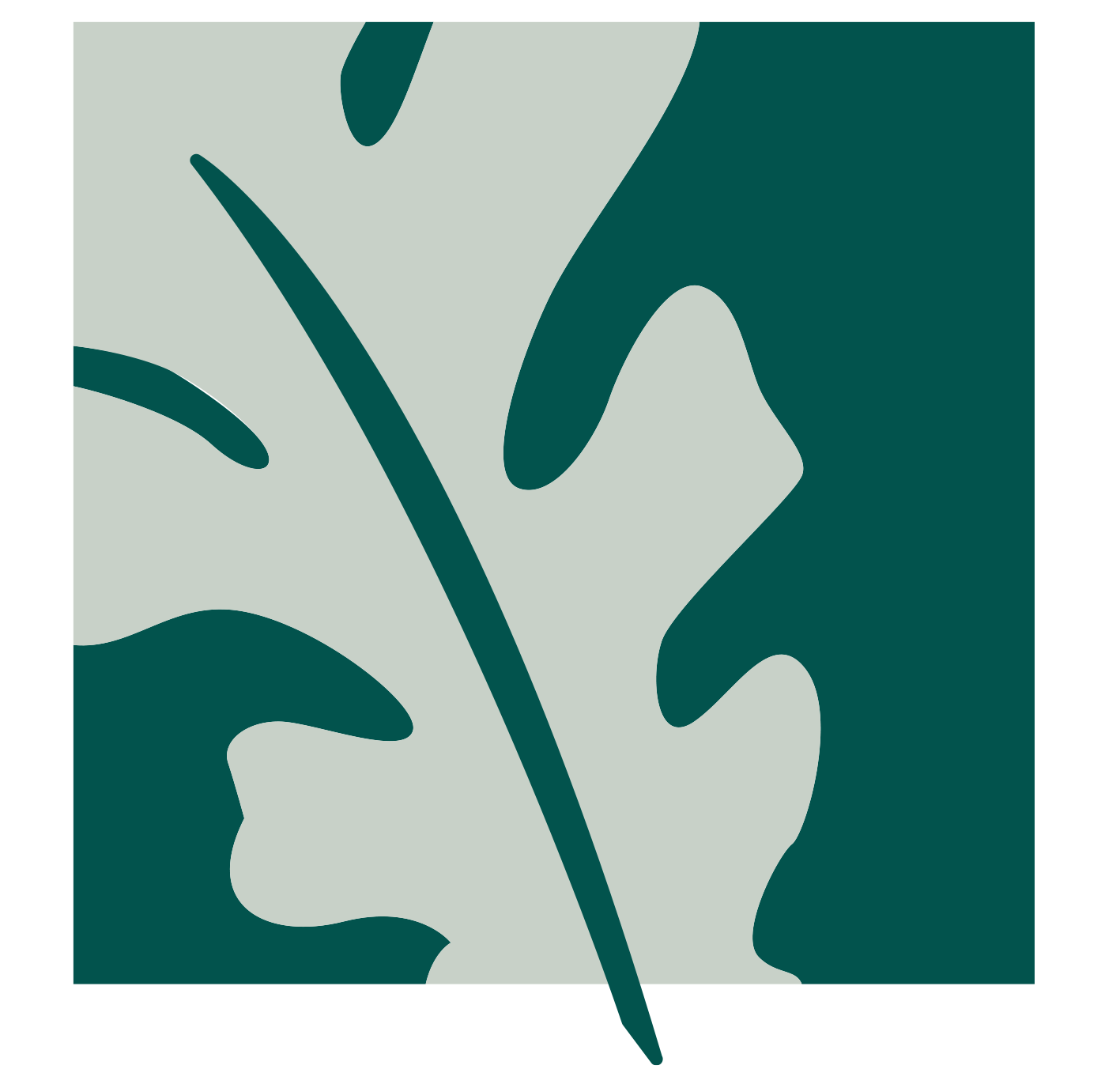Future Favorites
The climate is changing, and so are our plant recommendations. Enter Future Favorites, a new and evolving list of plants that our horticulturists have identified as thriving in today’s shifting climate. Many of these plants overlap with the original Arboretum All-Stars, while new additions reflect observations about how specific species are responding to increased heat, changing rainfall patterns, and other environmental challenges. Learn more about Future Favorites.
For more inspiration, see our Arboretum All-Stars, other plant lists, and download our Future Favorite list here.
Picks from Spring 2025

Sentinel Vine Hill manzanita
Arctostaphylos ‘Sentinel’
This drought tolerant, evergreen shrub has an attractive and sturdy habit that is one of the most garden-tolerant manzanitas. This fairly fast growing manzanita is a wonderful addition for bird and butterfly gardens. It is a bumblebee favorite! It features reddish bark, pale pink flowers and edible fruit. It will tolerate heavy soil but prefers sandy loam. Needs good drainage. Summer water every 3 to 4 weeks when established.
- ☀️: Sun
- 💧: Low irrigation
- 🌱: California native
- 📏: 6 ft tall, 6 ft wide

Australian bluebell creeper
Billardiera heterophylla
A climbing, evergreen shrub that will grow 3 feet as a shrub, but with support it will reach 6 feet tall or higher. The nodding bright blue bell-shaped flowers bloom in the summer. Plant in sun (along coast) or part shade and water occasionally - it is drought tolerant once established but looks best with regular irrigation. Older plants hardy below 25° F but young plants are more frost tender. Shows promise in first exposure beach plantings and grows well under Eucalyptus trees but is intolerant of overly wet slow draining soils and can reseed in the garden.
- 🌤️/☀️: Part shade or sun
- 💧: Low irrigation
- 🌱: Australia native
- 📏: 3-7 ft tall, 6 ft wide

Western spice bush
Calycanthus occidentalis
This deciduous shrub has maroon-red flowers that appear in mid-spring and summer, accenting the bright green fragrant leaves. On the first day that the flowers open, they smell like wine; as they age they smell like brown sugar. Water deeply every 2 weeks or weekly. Tolerates sand, clay, no drainage and seasonal flooding. USDA zones 7-10.
- 🌤️/🌥️: Part shade or shade
- 💧: Moderate irrigation
- 🌱: California native
- 📏: 12 ft tall, 15 ft wide

brown-twigged dogwood
Cornus glabrata
Springtime clusters of white flowers mature to bluish-white berries and are beloved by birds. Green leaves on arching, brown-barked branches turn red in fall. This deciduous shrub can reach up to 10 feet tall and 6.5 feet wide while in moist shade. In full sun and lower irrigation, it will stay more compact. Water deeply once a month. Tolerates clay. USDA zones 7-10.
- 🌤️/☀️: Part shade or sun
- 💧: Low irrigation
- 🌱: California native
- 📏: 10 ft tall, 6.5 ft wide

Cooper’s ice plant
Delosperma cooperi
Brilliant magenta-purple, red, yellow, or orange flowers keep blooming from spring through fall on this spreading evergreen groundcover. Succulent, bright green, cylindrical leaves. Good for container gardening. Water deeply every 3 to 4 weeks. Well-drained soil. USDA zones 6-10.
- ☀️: Sun
- 💧: Low irrigation
- 🌱: South Africa native
- 📏: 3 in tall, 18 in wide

sea squill
Drimia maritima
In late summer the towering 6 ft flower stems appear and culminate in a spike of progressively opening starry white flowers. This summer deciduous bulb has a rosette of wavy grey-green leaves that die back before the flowers appear. Bulbs form above ground clumps. Irrigation not needed. Provide well drained soil. USDA zones 8-11.
- ☀️: Sun
- 💧: Very low irrigation
- 🌱: Mediterranean Basin native
- 📏: 3 ft tall, 3 ft wide
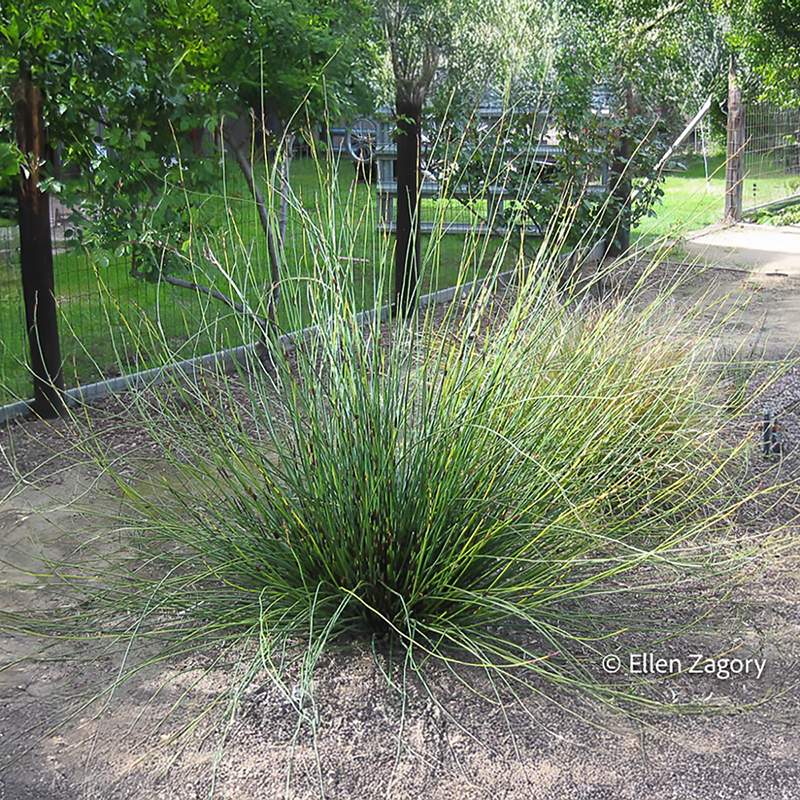
small Cape rush
Elegia tectorum
Dense clump of green, grass-like stems are tipped with eye-catching chocolate brown flower spikes. Reed, evergreen, 3 feet tall and as wide. Water deeply every 2 to 3 weeks. Well-drained soil. No pruning needed but every few years cut old growth to the ground as new sprouts begin to show in spring. USDA zones 9-11.
- 🌤️/☀️: Part shade or sun
- 💧: Low irrigation
- 🌱: South Africa native
- 📏: 3 ft tall, 4 ft wide
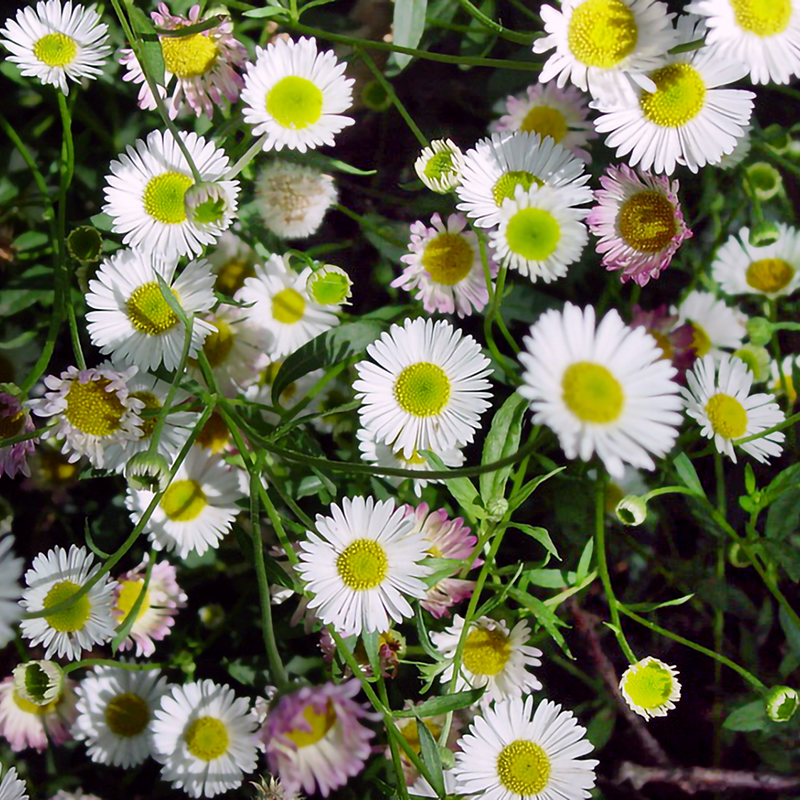
Santa Barbara daisy
Erigeron karvinskianus
In all seasons small, perfect white daisies seem to float on a low cloud of slender stems and tiny leaves. Especially profuse from spring to fall, the daisies shrink and mature to dark pink. This evergreen perennial is attractive to butterflies, native bees, and beneficial insects. Cut back to new growth in winter to renew. Water deeply every 2 weeks or weekly. Well-drained soil. USDA zones 7-10
- ☀️: Sun
- 💧: Low irrigation
- 🌱: Mexico, Central America native
- 📏: 1 ft tall, 2-3 ft wide

California fescue
Festuca californica
This blue-green bunch grass is great for flowing down lightly shaded slopes. Airy spring-time flower spikes are green, turning purple and then yellow. This evergreen perennial grass has a naturally tidy, rounded form. Deadhead old flower stalks in summer. Water deeply every 3- 4 weeks. Well-drained soil. USDA zones 7-10.
- 🌤️/🌥️: Part shade or shade
- 💧: Low irrigation
- 🌱: California native
- 📏: 2 ft tall, 2 ft wide

California coffeeberry
Frangula californica
This evergreen shrub is useful for hedges and background planting. They have leathery, yellow-green leaves, red-purple stems, and clusters of berries that turn from green to orange-red to black as they ripen in August. They are not fussy about soil and are tolerant of pruning and shaping. Established plants need little water. Does best in part shade in the Sacramento Valley.
- 🌤️/🌥️/☀️: Part shade, shade or sun
- 💧: Low irrigation
- 🌱: California native
- 📏: 3-15 ft tall, 8 ft wide

coral yucca
Hesperaloe parviflora
Pink asparagus-like stalks emerge in spring and grow to 3 feet with bell-shaped coral flowers that bloom until November. This evergreen perennial, has narrow, curved leaves with white, soft threads on the leaf margins. This is a hummingbird magnet and is an excellent container plant. Water deeply every 2 to 4 weeks. Well-drained soil. USDA zones 5-10.
- 🌤️/☀️: Sun
- 💧: Very low irrigation
- 🌱: Texas, Mexico native
- 📏: 3-4 ft tall, 5 ft wide
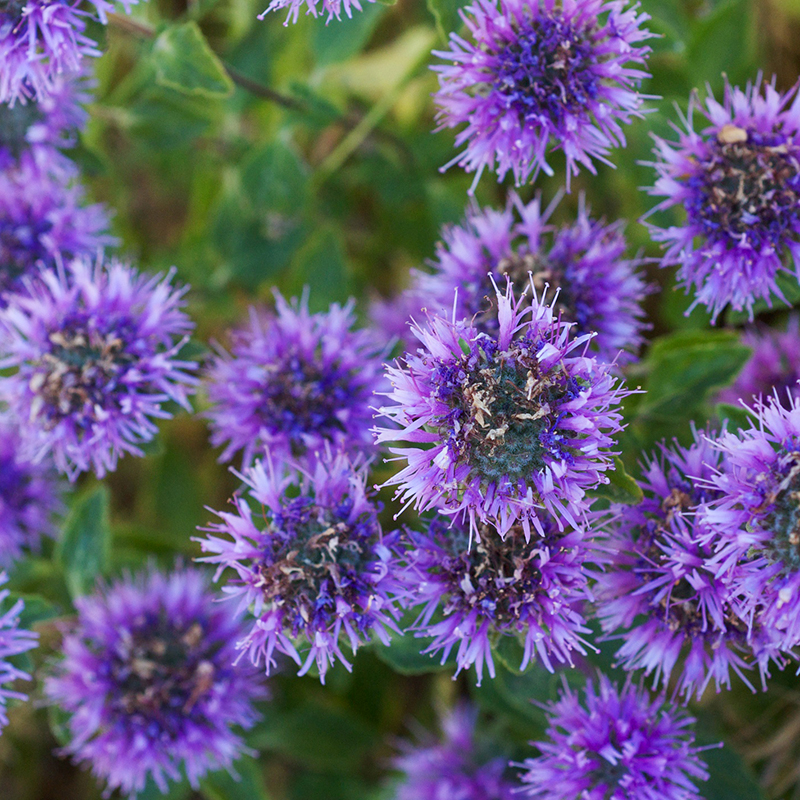
coyote mint
Monardella villosa
This coastal California native makes a nice groundcover for dry areas. Its fuzzy green foliage is minty-scented and keeps the deer away. The long blooming 1” lavender puff balls bloom July through August, providing nectar for bees and hummingbirds. Cut back in winter for compact appearance. Found in oak woodlands & chaparral, this plant can grow in sand, clay, or serpentine soil and does well on dry slopes. In the Sacramento Valley, we recommend growing in part sun. Deer resistant. Drought tolerant. USDA zones 7-10.
- ☀️: Part shade or sun
- 💧: Very low irrigation
- 🌱: California native
- 📏: 1 ft tall, 2 ft wide

deergrass
Muhlenbergia rigens
This evergreen perennial grass has slender yellow or purplish flower spikes that are upright in summer and then arch out giving the look of a fireworks display. Water deeply every 3 to 4 weeks. Deer proof. Pruning is only needed if the clump becomes disheveled. Plant about 5 feet from paths. USDA zones 6-10.
- ☀️: Sun
- 💧: Low irrigation
- 🌱: California native
- 📏: 4 ft tall, 6 ft wide

blue oak
Quercus douglasii
Slow growing oak that makes a nice shade tree. It has a somewhat irregularly-shaped crown, and a trunk that is 1.5-3 feet in diameter. The bark is light gray and the small leaves have a blue-green color. Flowers are hanging catkins of pollen flowers and inconspicuous ovulate flowers which mature to 1 inch long acorns. Blue oaks prefer full sun but will tolerate part shade, especially when young. They can handle occasional summer water (1x per month). Cold hardy to 0°F.
- ☀️: Sun
- 💧: Very low irrigation
- 🌱: California native
- 📏: 30-50 ft tall

evergreen currant
Ribes viburnifolium
Fragrant glossy foliage is accented with maroon stems and maroon flowers in late winter. They produce small fruits like polished garnets. This evergreen shrub has shiny leathery dark green leaves that look attractive all year. Water deeply every 2 weeks. Well-drained soil. Attracts hummingbirds and beneficial insects. A perfect tall groundcover for under deciduous trees. No pruning needed. Intolerant of hot afternoon sun. USDA zones 6-10.
- 🌤️/🌥️: Part shade or shade
- 💧: Low irrigation
- 🌱: California native
- 📏: 2-3 ft tall, 3-5 ft wide

California white sage
Salvia apiana
Arching sprays of pale lavender-tinged 4-5 ft flower stalks appear on pinkish stems in spring. Beautiful white-silver leaves are very strongly-scented. Water deeply every 2 to 4 weeks. Well-drained soil. This evergreen perennial has many traditional uses by California Native Americans. An excellent nectar source for bees. USDA Zones 8-11.
- ☀️: Part shade or sun
- 💧: Very low irrigation
- 🌱: California native
- 📏: 3-4 ft tall, 5 ft wide

Palmer’s sedum
Sedum palmeri
This evergreen succulent has gray-green fleshy leaves that are the backdrop for late winter rosettes of starry, brilliant yellow flowers. Water deeply once or twice a month. Well-drained soil. USDA zones 8-10.
- 🌤️/☀️: Part shade or sun
- 💧: Low irrigation
- 🌱: Mexico native
- 📏: 1 ft tall, 1-3 ft wide

Louis Hamilton desert mallow
Sphaeralcea ambigua ‘Louis Hamilton’
An attractive pollinator magnet with silvery green leaves and bright, coral, cup-shaped flowers. Long blooming season with low-mod water but also suitable for a dry garden. Cut back hard after flowering to maintain a tidy form.
- 🌤️/☀️: Part shade or sun
- 💧: Low irrigation
- 🌱: California native
- 📏: 2 ft tall, 2 ft wide
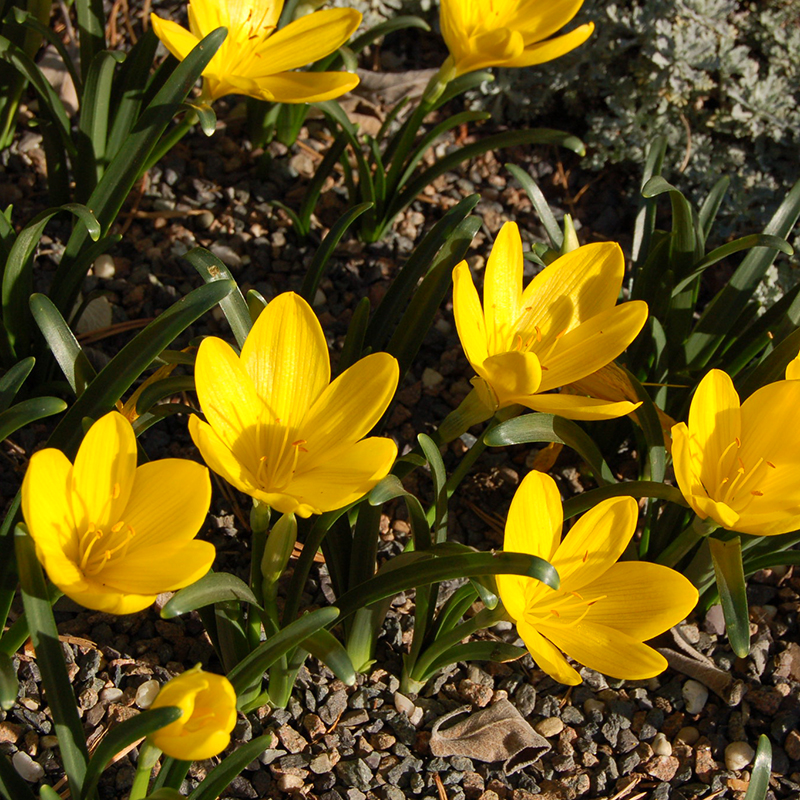
yellow autumn crocus
Sternbergia lutea
This summer deciduous bulb has golden-yellow, goblet-shaped, crocus-like flowers that bloom in September and October. No watering needed from May until early September when dormant; tolerates some summer irrigation in well-drained soil. Adds a colorful autumn surprise to the dry garden. USDA zones 6-9.
- ☀️: Sun
- 💧: Very low irrigation
- 🌱: Mediterranean Basin native
- 📏: 6 in tall, 6 in wide
Picks from Fall 2024

mangave
× Mangave cultivars
Mangaves are a hybrid that display the best qualities of each parent. They maintain the structural form of a small agave but lack the deadly spines and spreading behavior. They have colorful broad rosettes of leaves in a variety of colors and forms to choose from. They are evergreen and require little to no maintenance. They tolerate poor soils and infrequent watering.
- 🌤️/☀️: Part shade or sun
- 💧: Very low irrigation
- 🌱: Southwest US, Mexico native
- 📏: varies

Moonshine yarrow
Achillea ‘Moonshine’
Gray fern-like foliage looks good all year. Bright yellow summer blooms are abundant and dense and provide nectar for pollinators. A tried and true cultivar that is more tolerant of soil and irrigation ranges than many other yarrows. Perennial, evergrey, 18 inches tall and 2 feet wide. Water deeply 2-4 weeks. Well-drained soil is best. Deer resistant. USDA zones 3-9.
- 🌤️/☀️: Part shade or sun
- 💧: Low irrigation
- 🌱: North America, Europe, Western Asia native
- 📏: 15 in tall

octopus agave
Agave vilmoriniana
Narrow, furrowed leaves undulate and twist like the arms of an octopus. Structurally interesting but not spikey or spreading. Perfect for a hot, dry spot. After 5-10 years, a 15 foot flower stalk appears with yellow flowers that open in a spiral. Mother plant will perish but leave dozens of pups. Succulent, evergreen, 4 feet tall and 5 feet wide. Water deeply once every 3-4 weeks in summer. Provide good drainage. A great container plant. USDA zones 9-11.
- 🌤️/☀️: Part shade or sun
- 💧: Very low irrigation
- 🌱: Mexico native
- 📏: 4 ft tall, 4 ft wide

coral aloe
Aloe striata
Broad succulent rosettes are small and tidy at 1-2 feet wide and tall. Leaves can take on different hues depending on sun exposure. They can turn pinkish in the sun and have blue tones in the shade. Hummingbirds love the 2-3 foot orange flowers that bloom in the winter and spring.
- 🌤️/☀️: Part shade or sun
- 💧: low irrigation
- 🌱: South Africa native
- 📏: 2 to 3 ft tall

Pigeon Point coyote brush
Baccharis pilularis ‘Pigeon Point'
Makes a great ground cover or clipped hedge. Spring brings honey-scented, subtle yellow-green flowers that attract a great variety of pollinators. A California native shrub, evergreen, at least 2 feet tall and spreading to 6 feet or more. Water deeply every 2 to 4 weeks. Well-drained soil. Deer resistant. Prune in early spring to 3 inches every 3 years to keep it low and compact. USDA zones 7-10.
- 🌤️/☀️: Part shade or sun
- 💧: Low irrigation
- 🌱: CA native
- 📏: 2 to 3 ft tall, 9 ft wide

blue grama grass
Bouteloua gracilis
A tidy, small California native grass with narrow, fine-textured green blades in summer. By mid summer into fall it displays a showy right-angled golden seed head that resembles a bushy eyelash. Goes dormant in winter when it can be cut back if preferred. Grows to 10 inches tall and as wide. A California native and UC Davis Arboretum All-Star. Provides habitat for skippers! Full sun or partial shade. Water every 2-4 weeks in summer. Well-drained soil. USDA zones 3-10.
- ☀️: Sun
- 💧: Low irrigation
- 🌱: Southwest US, Mexico native
- 📏: Up to 9 in tall

Valley Violet maritime ceanothus
Ceanothus maritimus ‘Valley Violet’
A selection of our native California lilac known for its resilience in Central Valley conditions. Showy long branches of bright violet flowers are the first California lilac to bloom in spring. Evergreen and growing to 3 feet tall and 5-6 feet wide. No maintenance required. A UC Davis Arboretum All-Star. Can withstand no summer irrigation or irrigation every 2 to 4 weeks. Excellent habitat value. USDA zones 8-10.
- 🌤️/☀️: Part shade or sun
- 💧: Low irrigation
- 🌱: CA native
- 📏: 3 ft tall, 5 ft wide

firecracker plant
Dicliptera squarrosa
Clusters of bright orange tubular flowers bloom summer to fall atop velvety, bluish-gray foliage. A true hummingbird magnet that is not finicky, or fazed by heat and drought. Perennial, winter dormant, 2 feet tall and 3 feet wide. Water deeply every 2 to 3 weeks. USDA zones 7-9.
- 🌤️/☀️: Part shade or sun
- 💧: Low irrigation
- 🌱: Central South America native
- 📏: 20 in tall, 3 ft wide
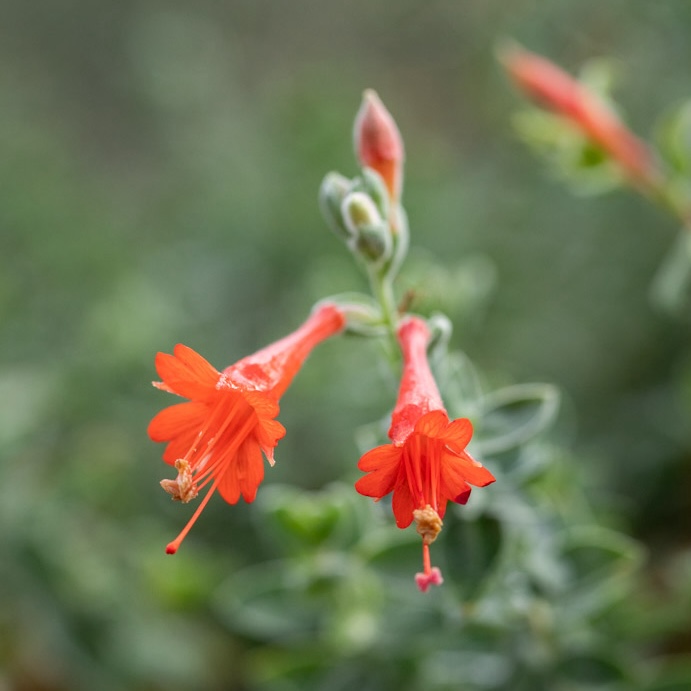
California fuchsia
Epilobium canum cultivars
Hummingbirds love the red-orange trumpet-shaped flowers atop gray-green leaves in late summer and fall. A=We have a variety of cultivars to choose from to pick flower and leaf color, and height. Give it space to spread widely in the garden, especially if watering frequently. A California native perennial and a UC Davis Arboretum All-Star. Water deeply every 2 to 3 weeks. Cut to the ground in winter to keep tidy. USDA zones 7-11.
- 🌤️/☀️: Part shade or sun
- 💧: Low irrigation
- 🌱: Western US native
- 📏: Varies

California buckwheat
Eriogonum fasciculatum (dwarf cultivars)
Low green mounds are ornamented in spring and summer with white flowers that age to pink, and then to cinnamon and dark brown. Perennial, evergreen, 11 inches tall spreading to 6 feet, makes an attractive groundcover. Water deeply every 2 or 3 weeks. Well-drained soil. Attracts bees, butterflies, and seed-eating birds. USDA zones 9-10.
- ☀️: Sun
- 💧: Low irrigation
- 🌱: Southwest US, Mexico native
- 📏: Varies

Apache plume
Fallugia paradoxa
White delicate, floaty, rose-like flowers give way to showy plumes of pale pink seeds that catch the light and make an impressive cloud effect. A California native semi-evergreen desert shrub, growing 5-6 feet tall and wide. Water every 2-4 weeks in summer. Prefers well-drained soil. Attracts pollinators. USDA zones 4-9.
- ☀️: Sun
- 💧: Low irrigation
- 🌱: Southwest US, Mexico native
- 📏: 2 ft tall, 4 ft wide

wood strawberry
Fragaria vesca
Delicate white flowers in late spring through summer give way to delightful, tiny strawberries. A gourmet treat. A perennial California native, evergreen, 4 inches tall and spreading, makes a good groundcover. Water deeply ever 1-3 weeks. Best in filtered shade, but adaptable. USDA zones 5-9.
- 🌤️/☀️: Part shade or sun
- 💧:Low irrigation
- 🌱: North America native
- 📏: 6 in tall, 1 ft wide

serpentine coffeeberry
Frangula californica subsp. tomentella
Gray felty leaves with inconspicuous white flowers followed by berries that turn from green to red to black as they age. Birds love the berries. A California native evergreen shrub growing to 10 feet tall and 14 feet wide. Water deeply every month. Well-drained soil. USDA zones 7-9.
- 🌤️/☀️: Part shade/sun
- 💧: Low irrigation
- 🌱: CA native
- 📏: 6 to 10 ft tall
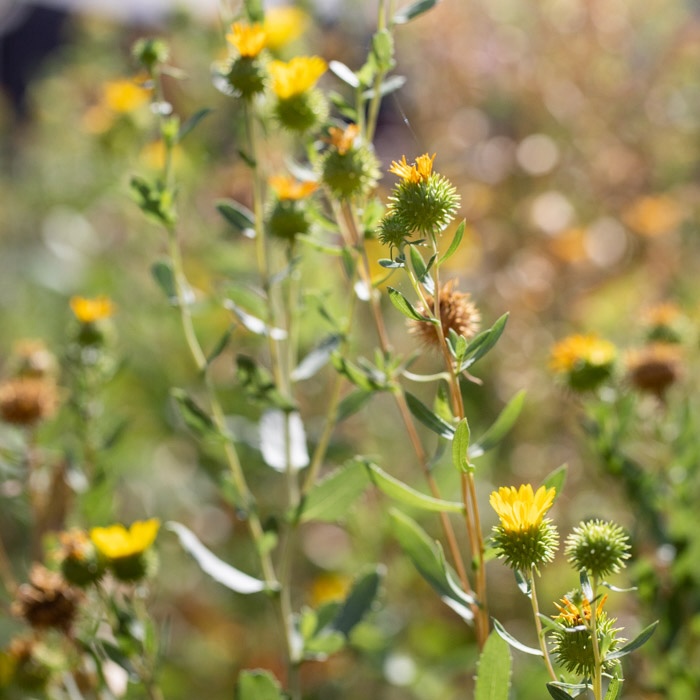
Great Valley gumweed
Grindelia camporum
Yellow daisy-like flowers have sticky buds and bloom in summer over green foliage. A need-to-have plant for the pollinator garden. A California native perennial, 3 feet tall and wide. Cut back at will to prevent ranginess. Best in full sun. Water deeply every 2-4 weeks. Deer resistant and tough as nails. USDA zones 7-10.
- ☀️: Sun
- 💧: Low irrigation
- 🌱: CA native
- 📏: Up to 1 ft tall

oakleaf hydrangea
Hydrangea quercifolia
Long panicles of huge summertime blooms that begin white and fade to dusty rose. Small to medium sized shrub with rich green foliage that turns maroon in the fall. Prefers some shade. Tolerates a wide range of irrigation including very little and a wide range of soils! USDA zones 5-9.
- ☀️,🌤️,🌥️: Sun, part sun or shade
- 💧: Low irrigation
- 🌱: Southeast US native
- 📏: Varies

common rush
Juncus patens
Upright clumps of stiff, blue gray grass-like foliage are adorned with small clusters of star shaped brown flowers in late spring. Enjoy the architectural form in the garden or in a container. A California native excellent for bioswales. Evergreen rush, to 2 feet tall, and as wide. Withstands a wide range of conditions; from drought to standing water. USDA zones 6-10.
- 🌥️,🌤️: Shade or part shade
- 💧: Low irrigation
- 🌱: CA native
- 📏: Up to 2 ft tall

Mexican honeysuckle
Justicia spicigera
Clusters of narrow, tubular orange flowers bloom from spring through fall, and sometimes in winter where weather is mild, offering a nectar source for butterflies and hummingbirds. Evergreen light green foliage, up to 4 feet tall and as wide. Water deeply once every two weeks. Deer resistant. Lightly prune to shape in late winter. USDA zones 9-11.
- 🌤️: Part shade
- 💧: Low irrigation
- 🌱: Mexico and Central America native
- 📏: Up to 4 ft tall

Texas ranger
Leucophyllum frutescens cultivars
Have a hot, sunny spot? This medium sized shrub has an impressive floral show in the depths of summer that pollinators love. We have many cultivars to choose from with a diversity of heights, leaf and flower colors. All prefer full sun and can be watered every 2-4 weeks.
- ☀️: Sun
- 💧: Low irrigation
- 🌱: Texas, Mexico native
- 📏: Up to 8 ft tall

pomegranate
Punica granatum cultivars
Deep red-orange flowers attract pollinators in summer and create bright red pomegranate fruits in fall. Heat and drought tolerant and bountiful fruit. Large deciduous shrub or small tree. Water deeply 2-4 weeks. Prune at will and frequently to keep smaller. Overwatering causes fruit to split. Can be trained as a shrub, tree, or espalier. USDA zones 7-11.
- ☀️: Sun
- 💧: Low irrigation
- 🌱: Middle East and Central Asia native
- 📏: Up to 20 ft tall

coral fountain
Russelia equisetiformis
Cascading plumes of bright green stems bear a profusion of bright red tubular flowers all summer that hummingbird magnets. Grows to 3 feet tall and 5 feet wide. Water deeply every 2 weeks. Heat tolerant. Remove frost-killed stems. Easy to propagate from pencil-size stem cuttings taken in spring. USDA zones 9-11.
- 🌤️/☀️: Part shade or sun
- 💧: Low irrigation
- 🌱: Mexico native
- 📏: 2 ft tall, 5 ft wide

Bee’s Bliss sage
Salvia ‘Bee’s Bliss’
Whorls of lavender-blue flowers bloom on 1-foot spikes in spring and summer. The foliage is strongly fragrant. Spreading shrub, use as groundcover, evergreen, 18 inches tall and 6 feet wide. A California native. Water deeply every 2 weeks. Very well-drained soil. Attracts bees, butterflies and hummingbirds. USDA zones 8-10.
- ☀️: Sun
- 💧: Low irrigation
- 🌱: CA native
- 📏: 2 ft tall, 8 ft wide

Marine Blue germander sage
Salvia chamaedryoides ‘Marine Blue’
Spikes of true blue flowers bloom from late spring through fall, adding the perfect compliment to almost any perennial border. The foliage of this selection is greener than the straight species. Perennial, evergreen, 2 feet tall and as wide. Extremely tough and attractive. Water deeply every 2 weeks. Prefers well-drained soil. Attracts pollinators. USDA zones 7-10.
- 🌤️/☀️: Part shade or sun
- 💧: Low irrigation
- 🌱: Mexico native
- 📏: 18 in tall, 3 ft wide

Point Sal coastal purple sage
Salvia leucophylla 'Point Sal'
Whorls of lavender-pink flowers bloom in spring above silvery gray aromatic foliage. Drought tolerant and spreading, this is a great choice for slopes or bank stabilization. A California native shrub; evergray if watered in summer, 3 feet tall and 6 feet wide. Water deeply every 2 to 4 weeks. Prefers well-drained soil. Attracts butterflies and hummingbirds. USDA zones 8-10.
- 🌤️/☀️: Part shade or sun
- 💧: Low irrigation
- 🌱: CA native
- 📏: 3 ft tall. by 6 ft wide

common snowberry
Symphoricarpos albus var. laevigatus
Waxy white berries are real eye-catchers in fall and winter. They are edible but bitter. Green-gray foliage backs the tiny pink bells that bloom in summer. Shrub, deciduous, to 30 inches tall. Water deeply every 2 to 4 weeks. Well-drained soil. Attracts birds. USDA zones 4-10.
- 🌤️/☀️: Part shade or sun
- 💧: Low irrigation
- 🌱: CA native
- 📏: 3 ft tall, 6 ft wide
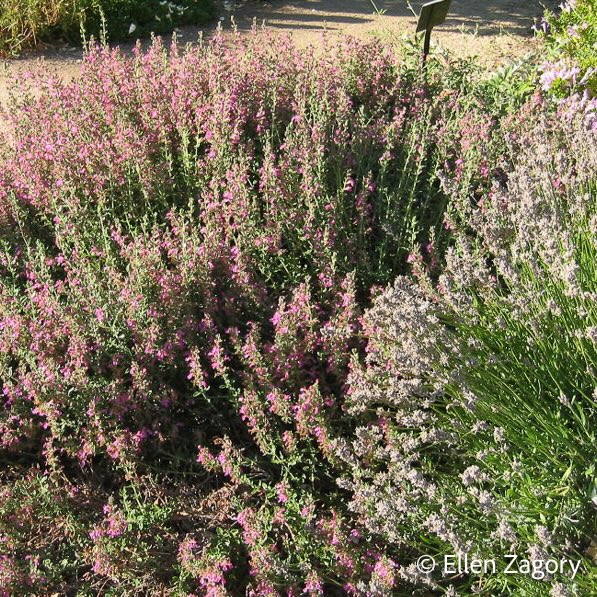
wall germander
Teucrium chamaedrys
Dainty pink flowers bloom in spring and summer amid evergreen dark green foliage. Can withstand high heat and low water. Perennial, evergreen, to 1 ft tall and spreading as a groundcover. Water deeply every 2 weeks or weekly. Well-drained soil. You can prune lightly to remove seed heads if desired, but not necessary. USDA zones 5-9.
- 🌤️/☀️: Part shade/sun
- 💧: Low irrigation
- 🌱: Mediterranean native
- 📏: 2 ft tall, 3 ft wide
Picks from Spring 2024
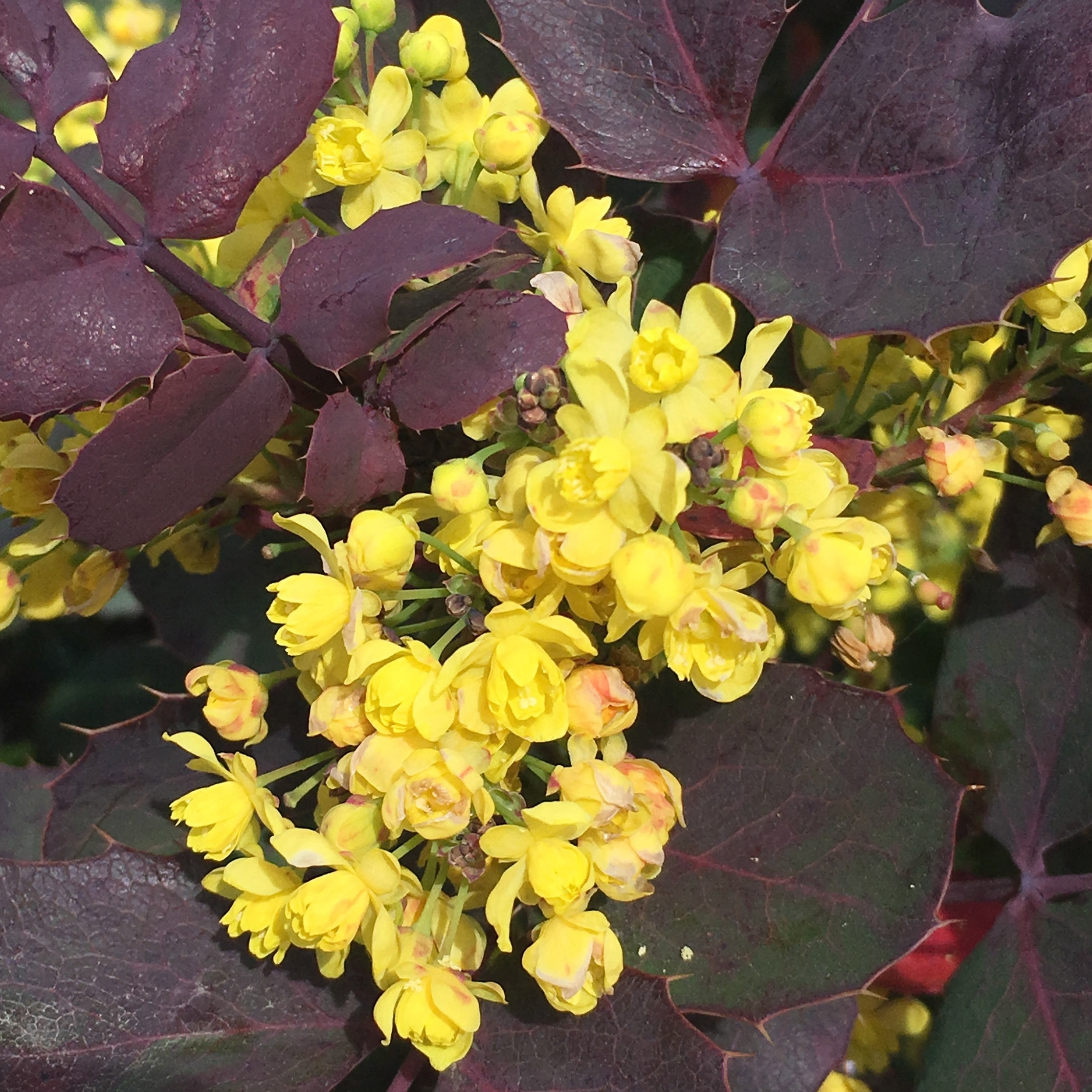
creeping Oregon grape
Berberis aquifolium var. Repens
This California native not only adds visual appeal to your garden with its charming evergreen foliage but also plays a vital role in supporting local wildlife. Its yellow winter flowers and purple berries attract and feed native birds, contributing to the overall health of your garden ecosystem.
- 🌤️/☀️: Part shade/sun
- 💧: Low irrigation
- 🌱: CA Native Plant
- 📏: 2.5 ft tall 4 ft wide
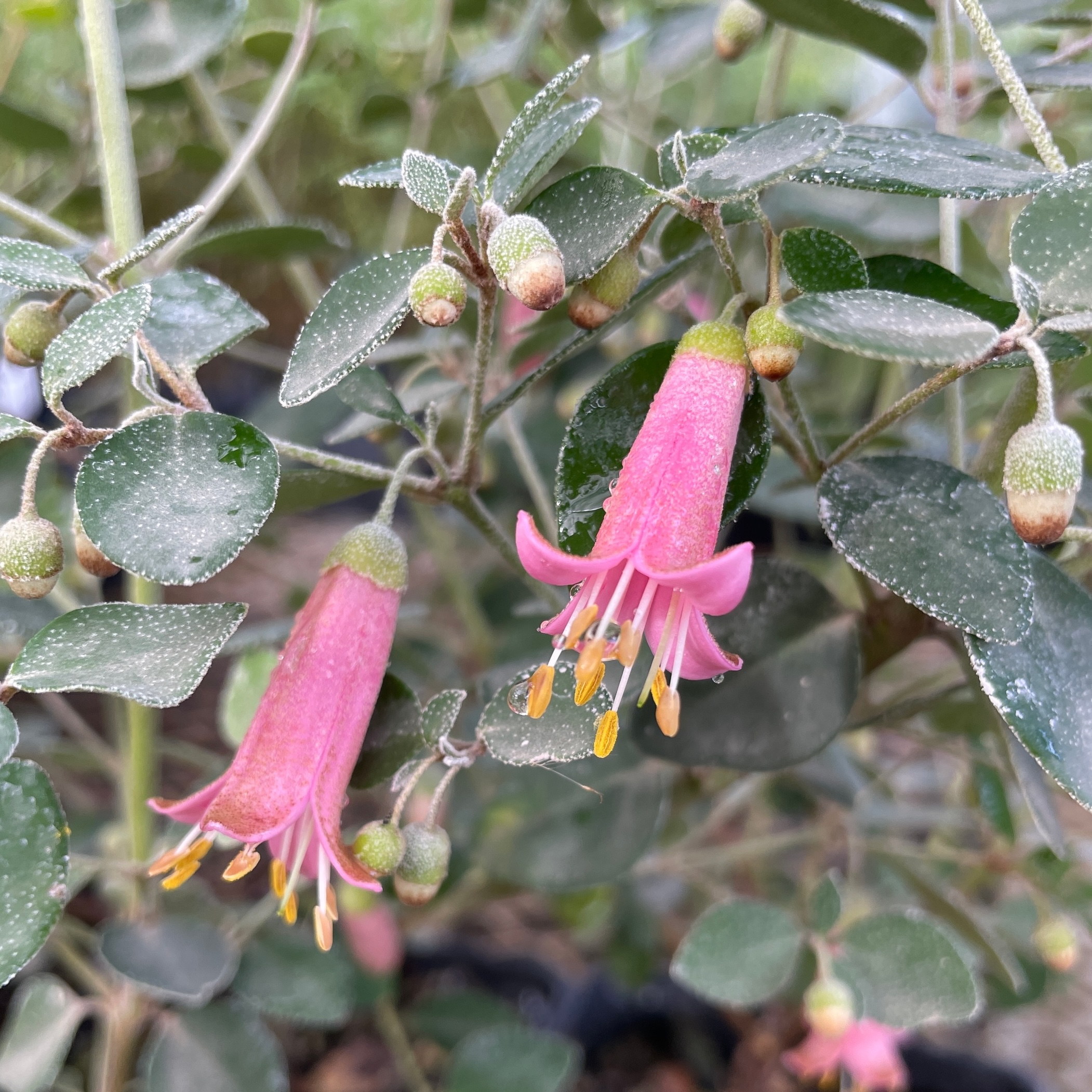
Pink Eyre Australian fuschia
Correa pulchella 'Pink Eyre'
Thriving with minimal summer irrigation, this drought-tolerant Australian native shrub brings bursts of cheerful blooms from November through February or March. The tubular flowers provide essential sustenance for nectar-loving hummingbirds.
- 🌤️: Part shade
- 💧: Low irrigation
- 🌱: Australian native
- 📏: 3 ft tall, 3 ft wide
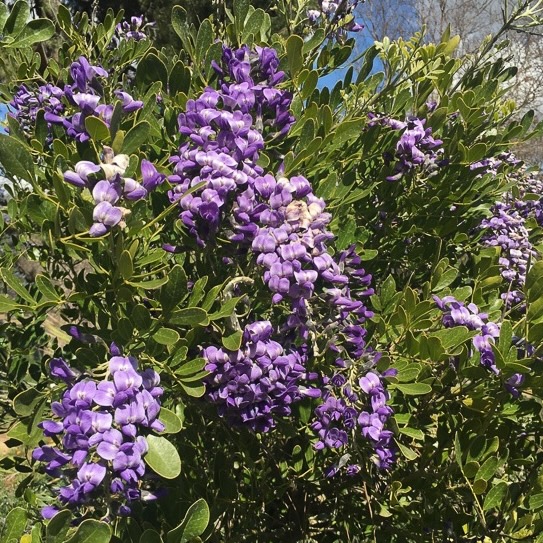
Texas mountain laurel
Dermatophyllum secundiflorum
This small, evergreen tree with glossy foliage withstands high temperatures and drought while offering lavender blooms with a unique grape soda scent in the early spring. The fragrance and flowers attract a diverse range of pollinators, enhancing the ecological balance in your garden.
- ☀️: Sun
- 💧: Low irrigation
- 🌱: Southwest US native
- 📏: 9 ft tall, 10 ft wide
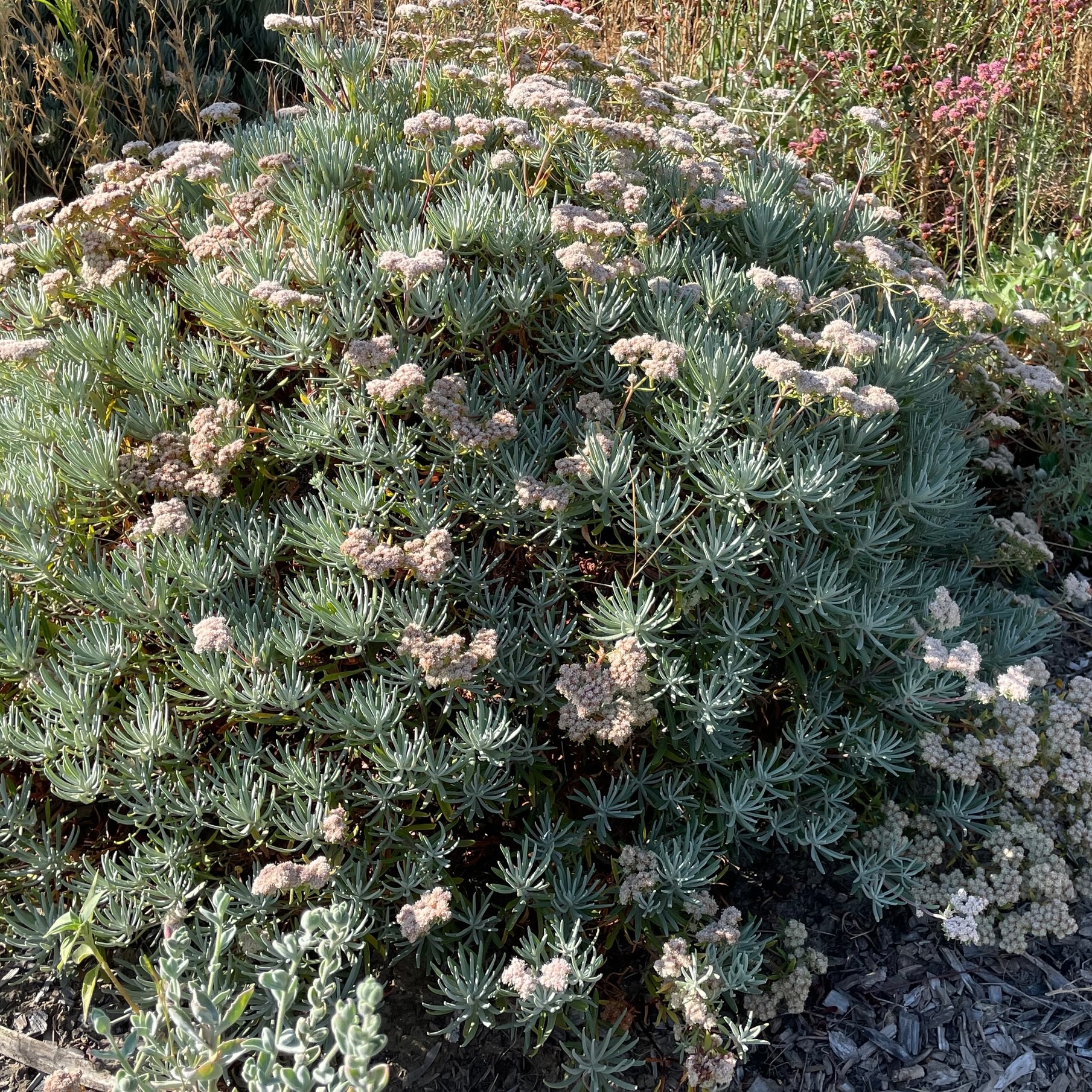
Santa Cruz Island buckwheat
Eriogonum arborescens
Standing at 3 feet tall, this drought-tolerant evergreen shrub graces your garden with rosy pink blooms in spring and summer that provide a feast for insect pollinators. As these blooms transition into red-brown seed heads in the fall, they become a valuable food resource for birds and bring architectural interest to the fall and winter garden.
- ☀️: Sun
- 💧: Low irrigation
- 🌱: CA Native Plant
- 📏: Up to 3 ft tall, 3 ft wide
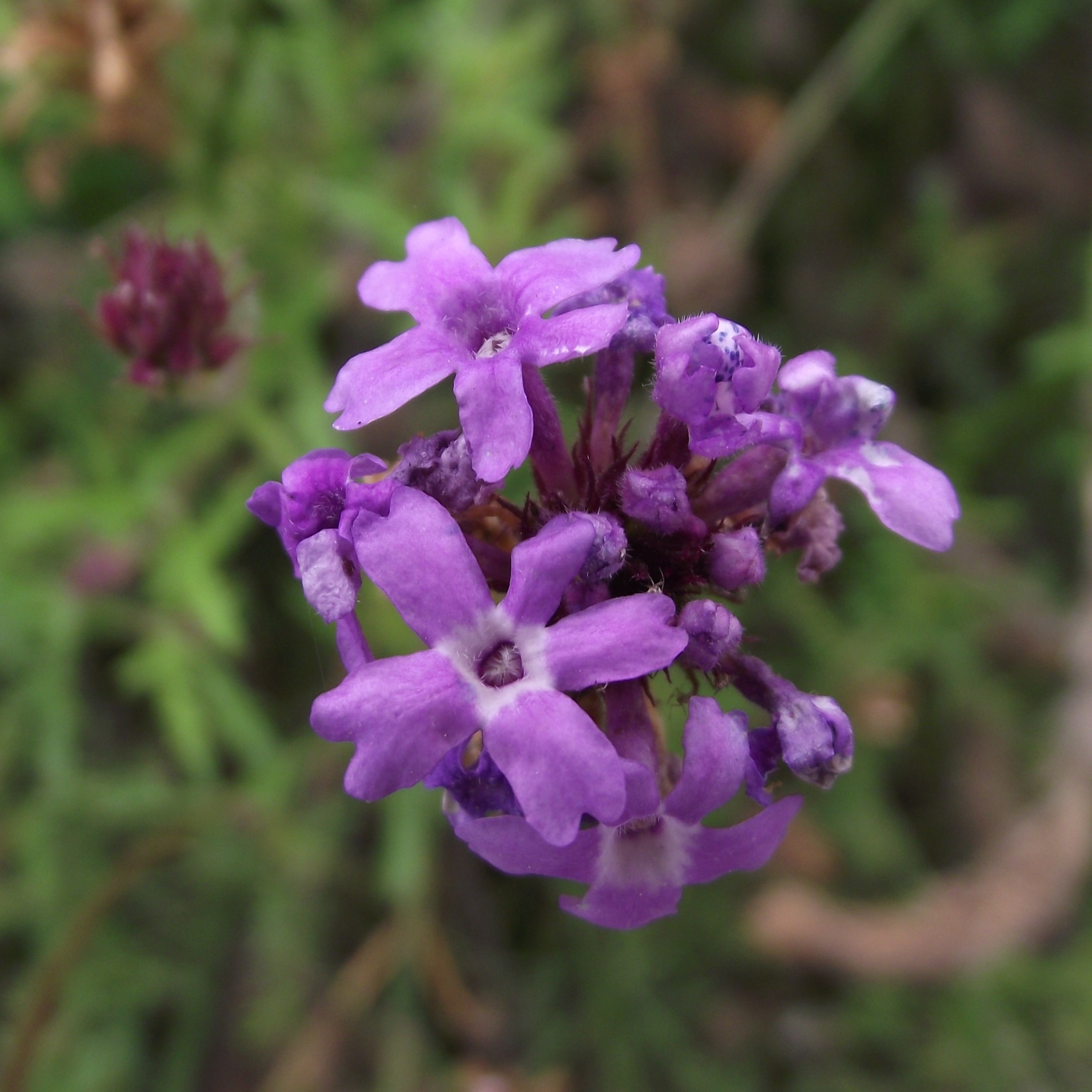
De la Mina verbena
Glandularia 'De La Mina'
A mounding perennial verbena that thrives in drought conditions, this plant serves as a pollinator haven, attracting bees, butterflies, and hummingbirds year-round. Although short-lived, its continuous blooms make it a central hub for pollinators in your garden. This plant makes a great border along paths and can be a one stop shop for your Potted Plants for Pollinators!
- 🌤️/☀️: Part shade/sun
- 💧: Low irrigation
- 🌱: Baja California native
- 📏: 3 ft tall, 4 ft wide
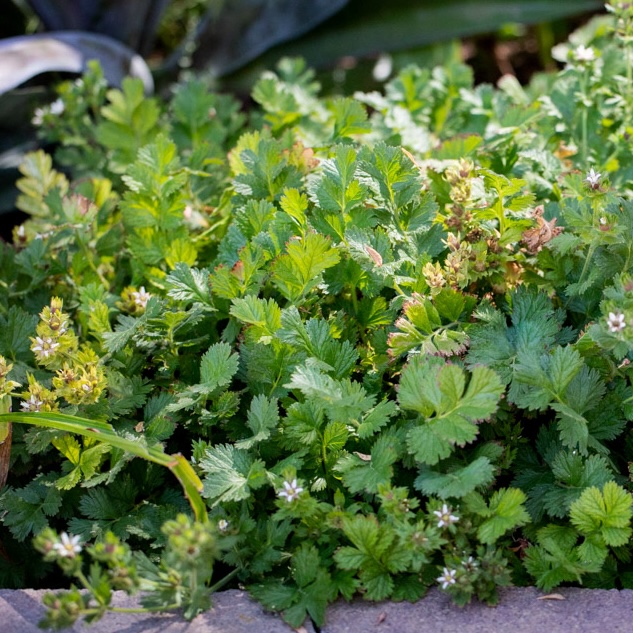
California honeydew
Horkelia californica
With soft fern-like foliage, this evergreen perennial gives a lush effect in the shade while requiring little summer water. The small white flowers act as a subtle yet powerful attraction for native bumblebees, making it an excellent choice for shaded areas dedicated to promoting bee-friendly environments.
- 🌥️/🌤️: Shade/part shade
- 💧: Low irrigation
- 🌱: CA native plant
- 📏: varies
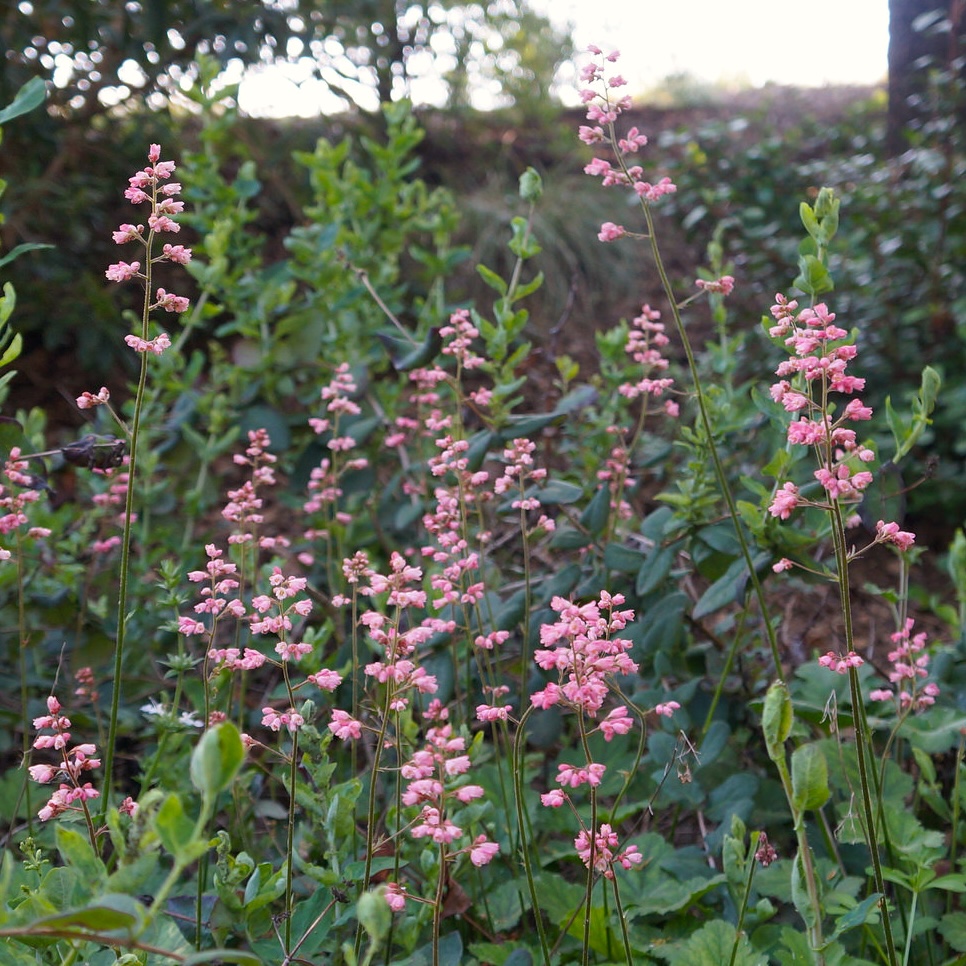
rosada coral bells
Heuchera 'Rosada'
This flowering perennial thrives in dry, shaded spaces, adding soft pink blooms to a garden while supporting local pollinators. The role of this California native extends beyond aesthetics, contributing to the ecological richness of your garden.
- 🌥️/🌤️: Shade/part shade
- 💧: Low irrigation
- 🌱: CA native plant
- 📏: 10-12 in tall, 2 ft wide
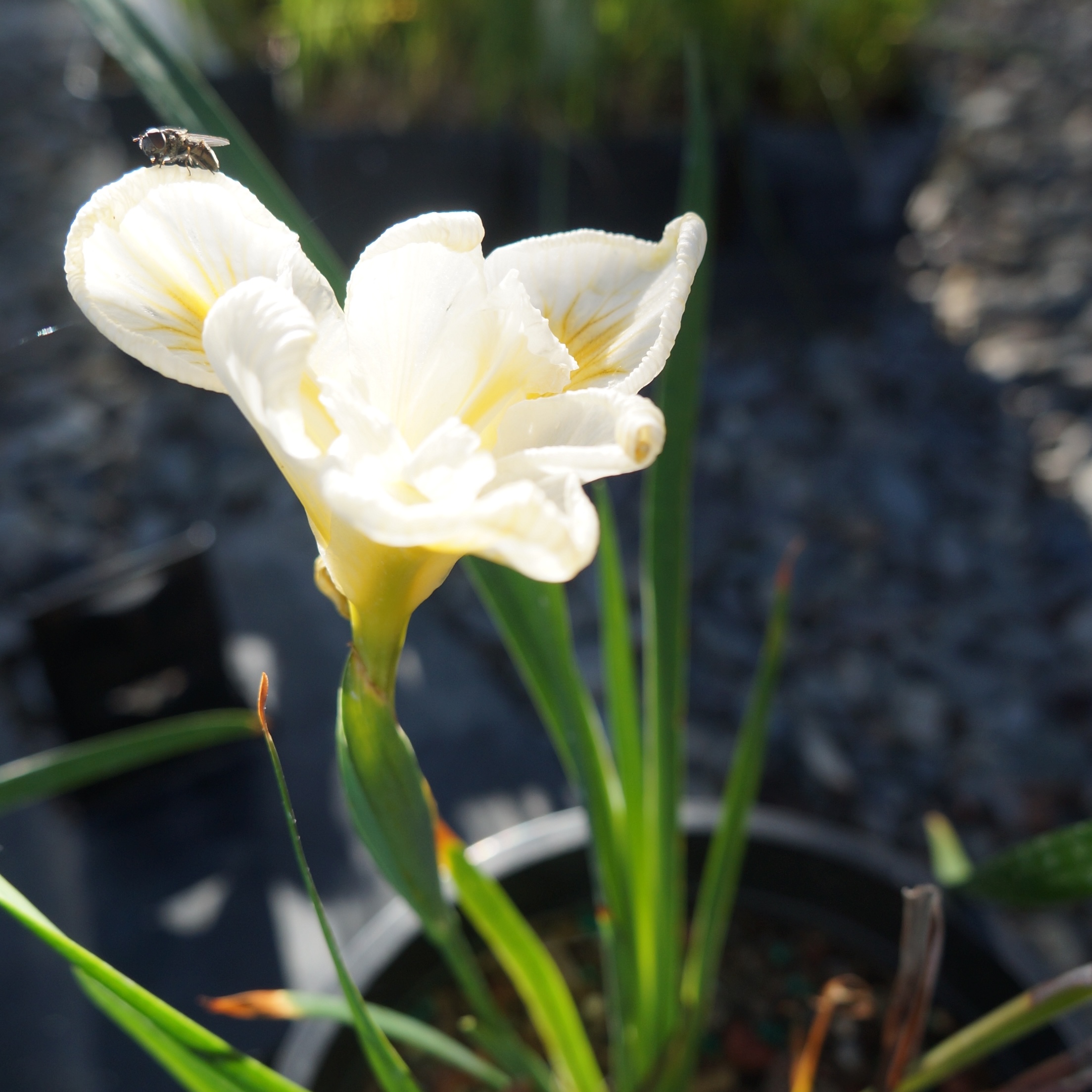
Iris Pacific Coast hybrid 'Canyon Snow'
Dependable and low-maintenance, this native hybrid iris brightens dry and shady gardens with white and yellow flowers. Its presence not only adds visual interest but also attracts native bee pollinators, contributing to the dynamic balance of your garden.
- 🌥️/🌤️: Shade/part shade
- 💧: Low irrigation
- 🌱: CA native plant
- 📏: 12-18 in tall, 3 ft wide
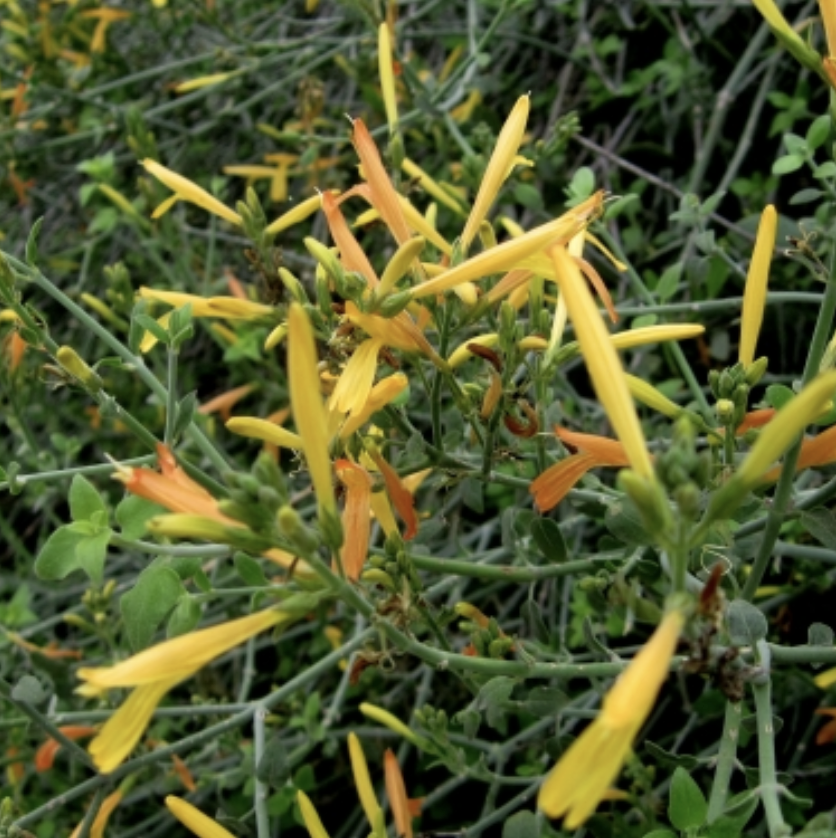
Yellow chuparosa
Justicia californica 'Yellow'
With its long and narrow golden flowers, this heat- and drought-tolerant desert shrub not only enhances your garden’s visual appeal from spring to fall but also serves as a favorite among hummingbirds. The continuous blooms makes it a reliable source of sustenance for these high energy polllinators.
- ☀️: Sun
- 💧: Low irrigation
- 🌱: CA Native Plant
- 📏: 5 ft tall, 5 ft wide
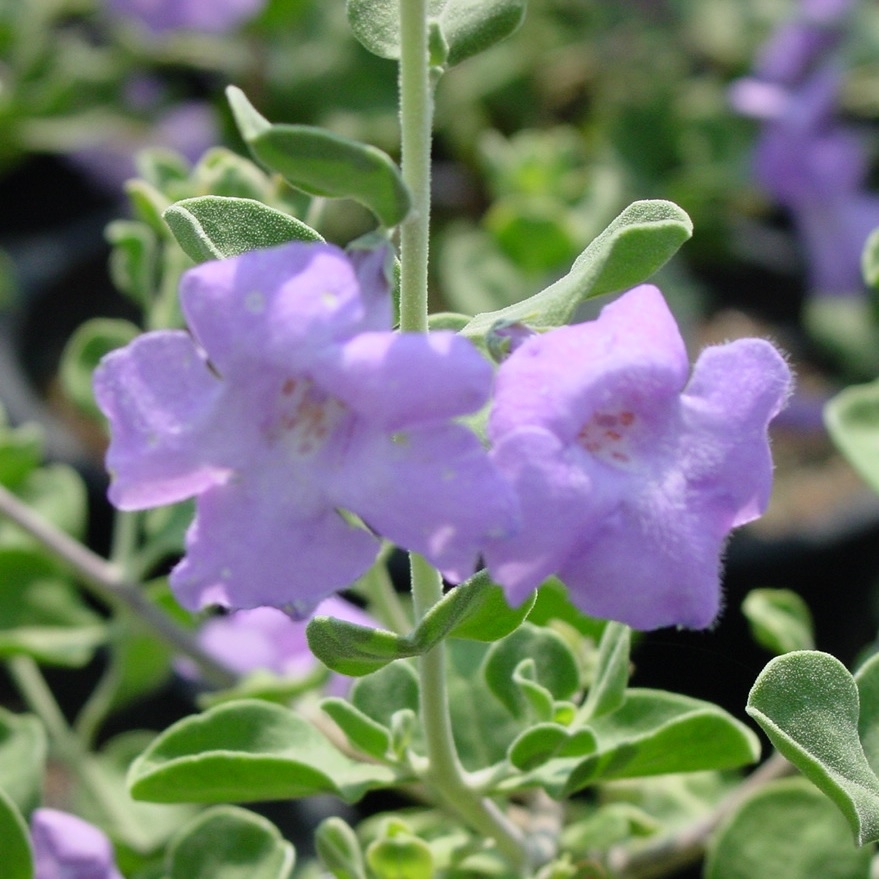
Lynn's Legacy cenizo
Leucophyllum langmaniae 'Lynn's Legacy'
Adaptable to heat, drought, and alkaline soil, this medium-sized shrub with fuzzy, light-green leaves is remarkably tough and resilient. The vibrant lavender-violet flowers burst into bloom in late summer and fall, enriching your garden with beauty and vitality during the driest season.
- ☀️: Sun
- 💧: Low irrigation
- 🌱: Southwest US native
- 📏: 5 ft tall, 5 ft wide
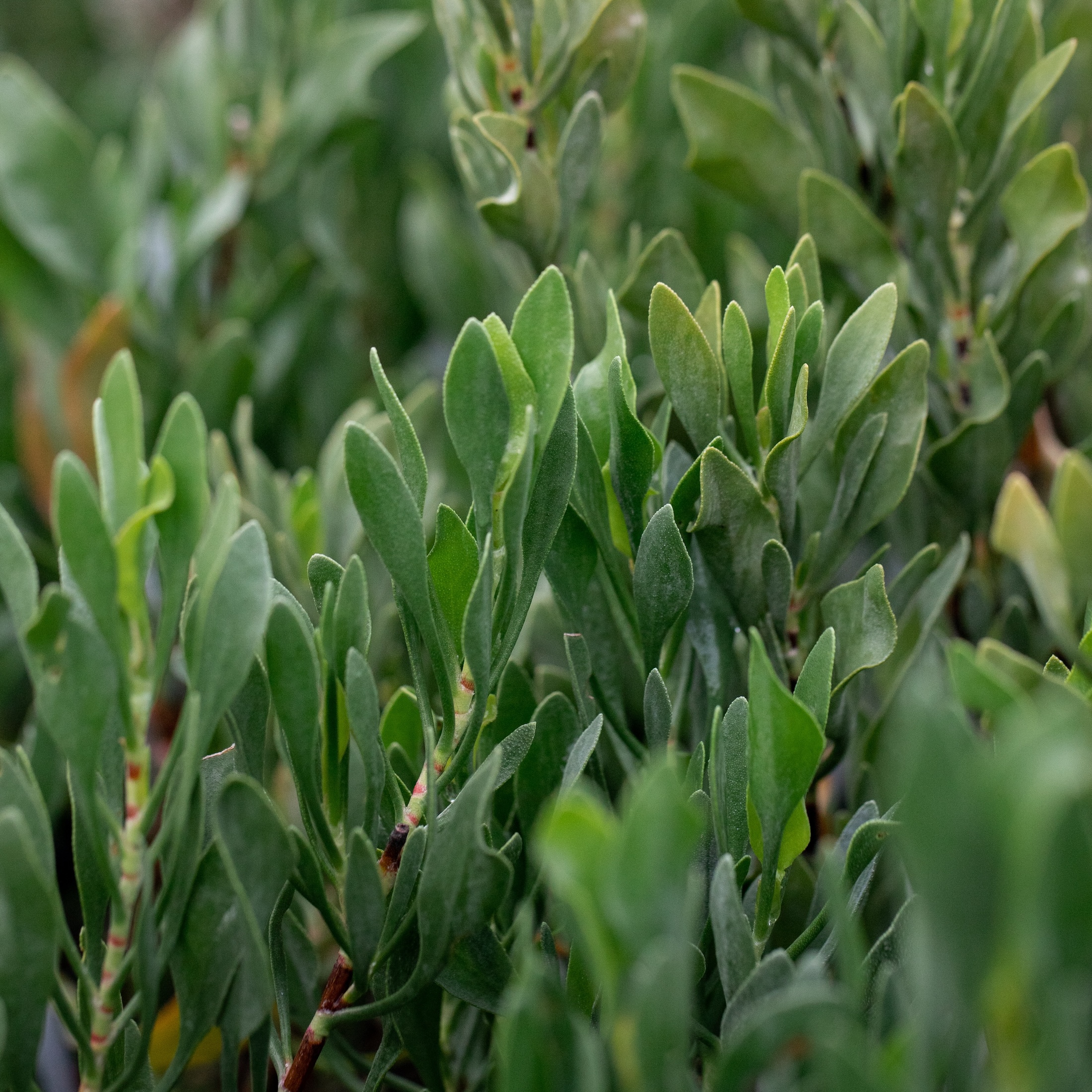
shrubby statice
Limoniastrum monopetalum
This remarkably tough weed smothering shrub thrives and provides dense ground cover with no summer irrigation. Clusters of small, lavender flowers in the spring become a haven for pollinators, adding both soft color and biodiversity to your garden.
- ☀️: Sun
- 💧: Low irrigation
- 🌱: Mediterranean native
- 📏: 3 ft tall 8 ft wide
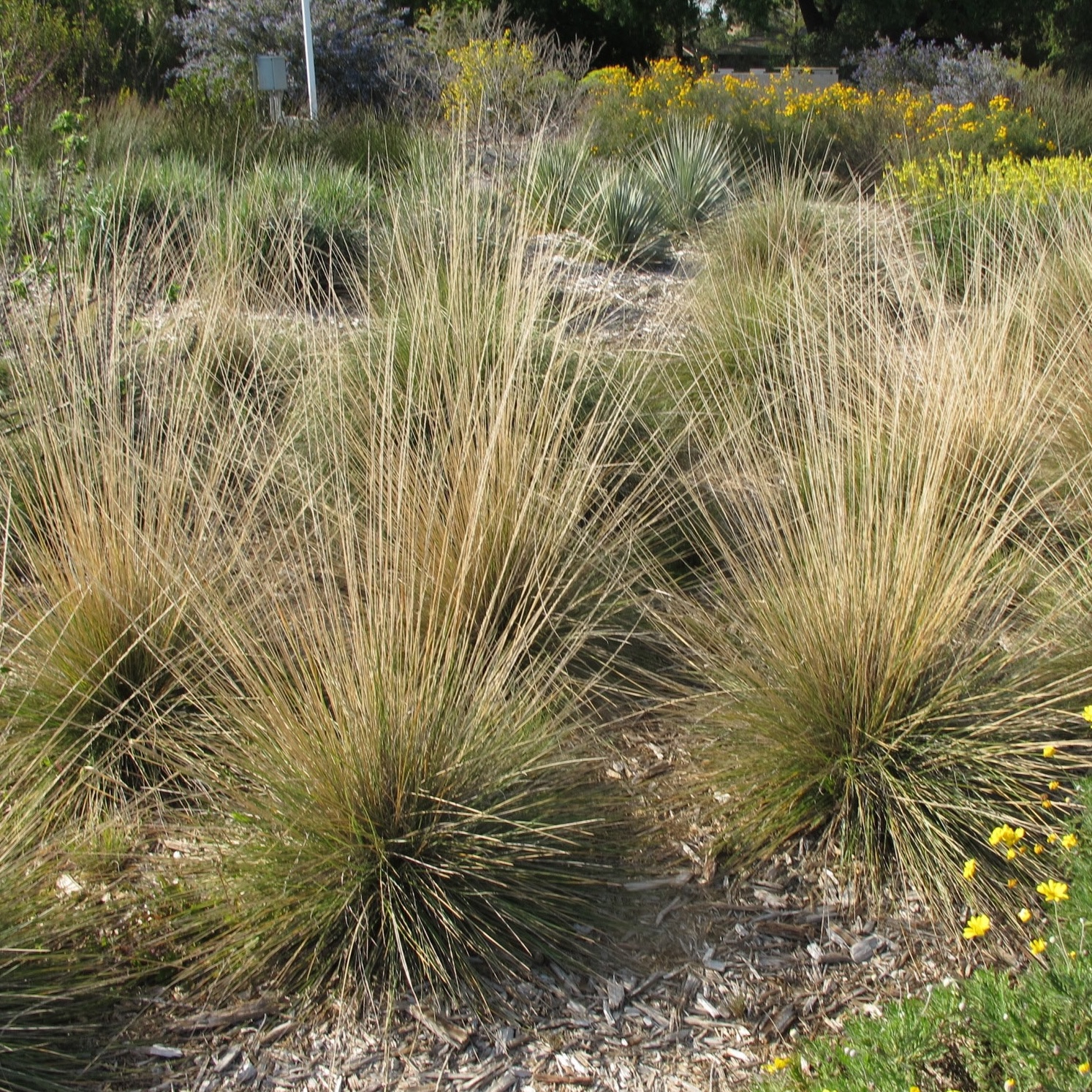
pine muhly
Muhlenbergia dubia
This fine, medium-sized grass adds texture and movement to dry, sunny gardens with minimal maintenance. Its presence not only enhances visual interest but also provides shelter and food sources for local wildlife, creating a haven for biodiversity in your garden.
- ☀️: Sun
- 💧: Low irrigation
- 🌱: Southwest US native
- 📏: 12-18 in tall, 12-18 in wide, with 3 ft flowering spikes
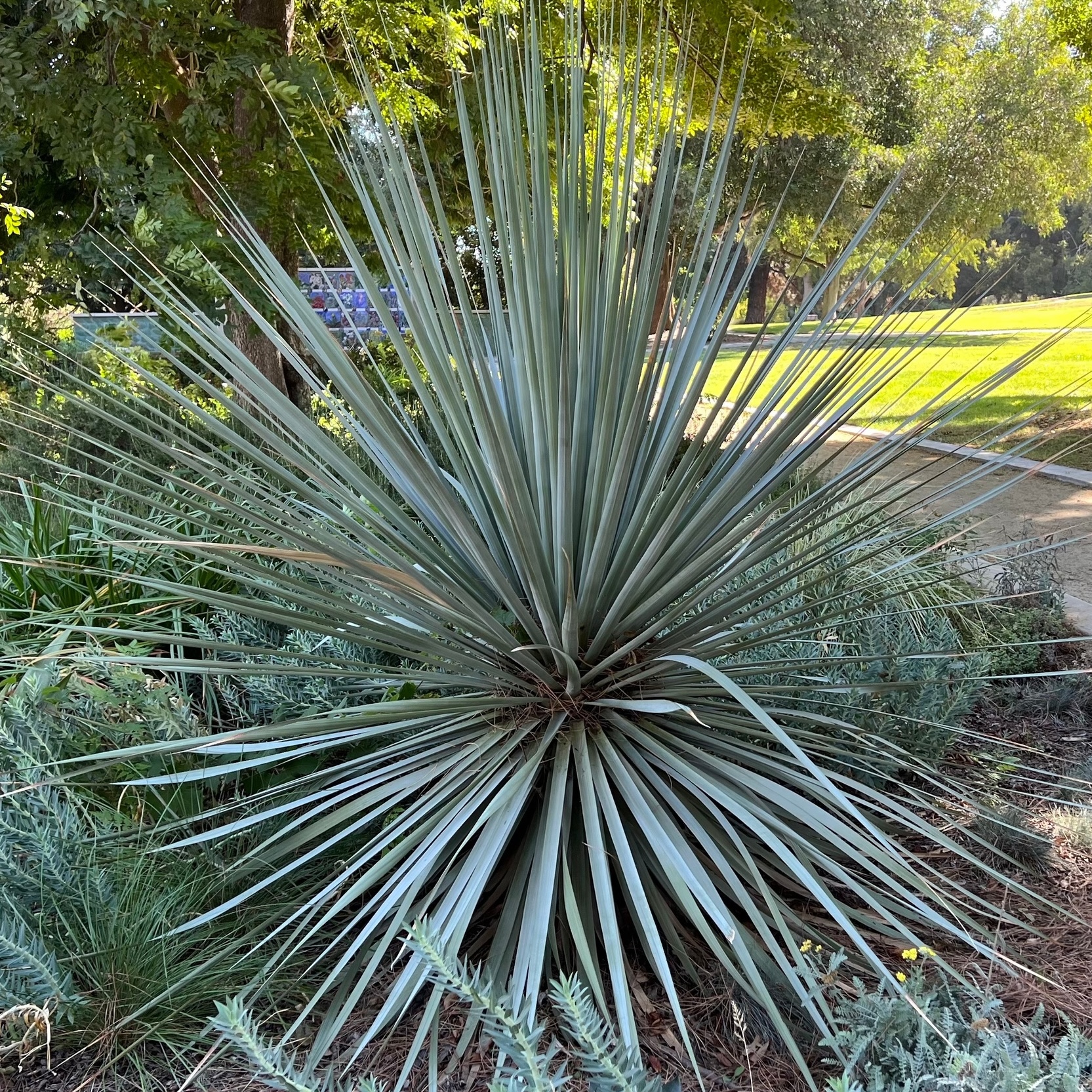
Nelson's blue beargrass
Nolina nelsonii
A strikingly sculptural succulent native to Mexico, this plant thrives in extreme heat, drought and cold weather. Its dense, spiky blue-green leaves are relatively soft and pliable unlike other more aggressive desert succulents. .
- ☀️: Sun
- 💧: Very low irrigation
- 🌱: Mexican native
- 📏: 4 ft tall, 8 ft wide
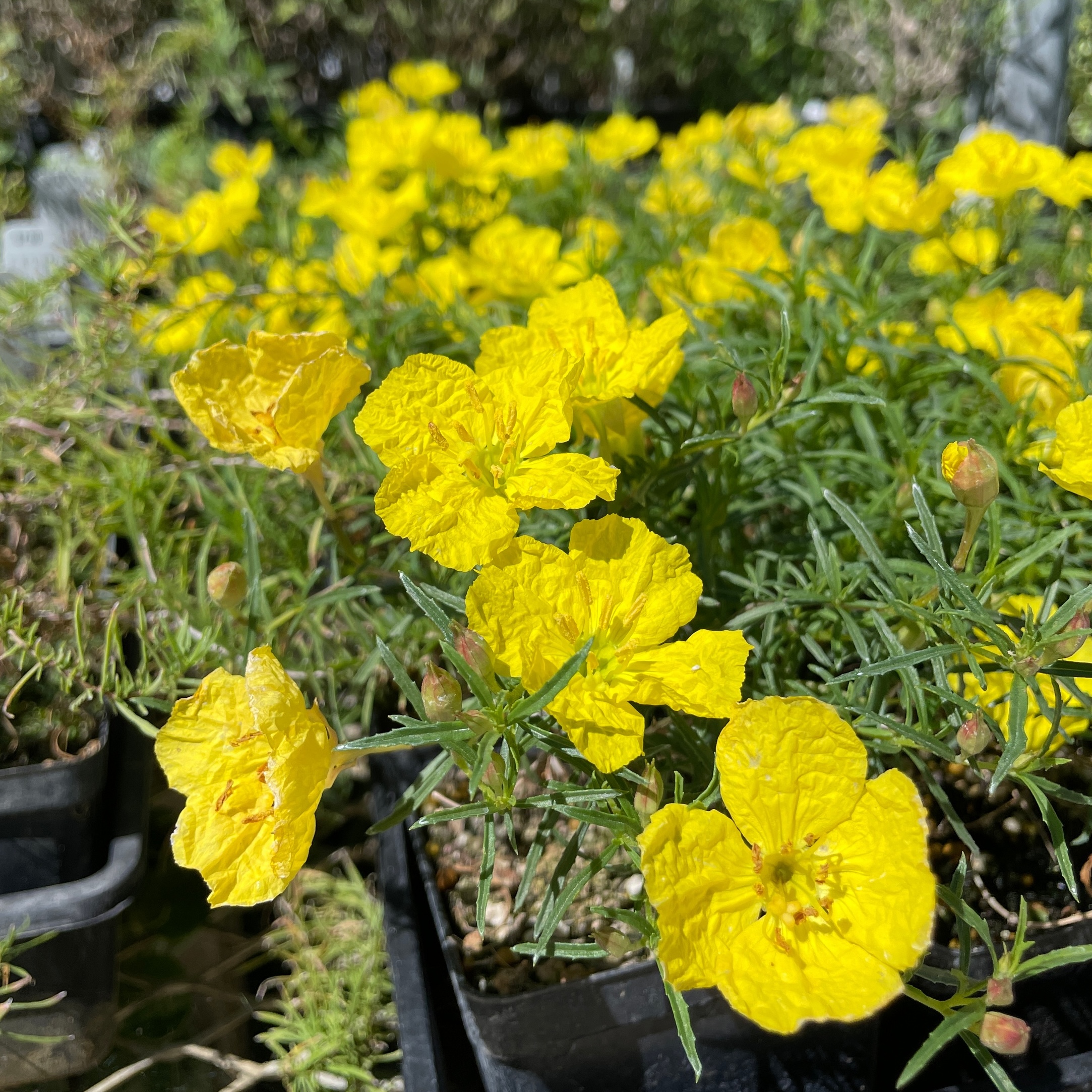
yellow sundrops
Oenothera serrulata
With narrow leaves and yellow blooms, this evergreen ground cover thrives in low-water gardens. Its bee-attracting flowers and minimal maintenance make it a valuable addition to any sustainable garden.
- 🌤️/☀️: Part shade/sun
- 💧: Low irrigation
- 🌱: Southwest US native
- 📏: 1 ft tall, 3 ft wide
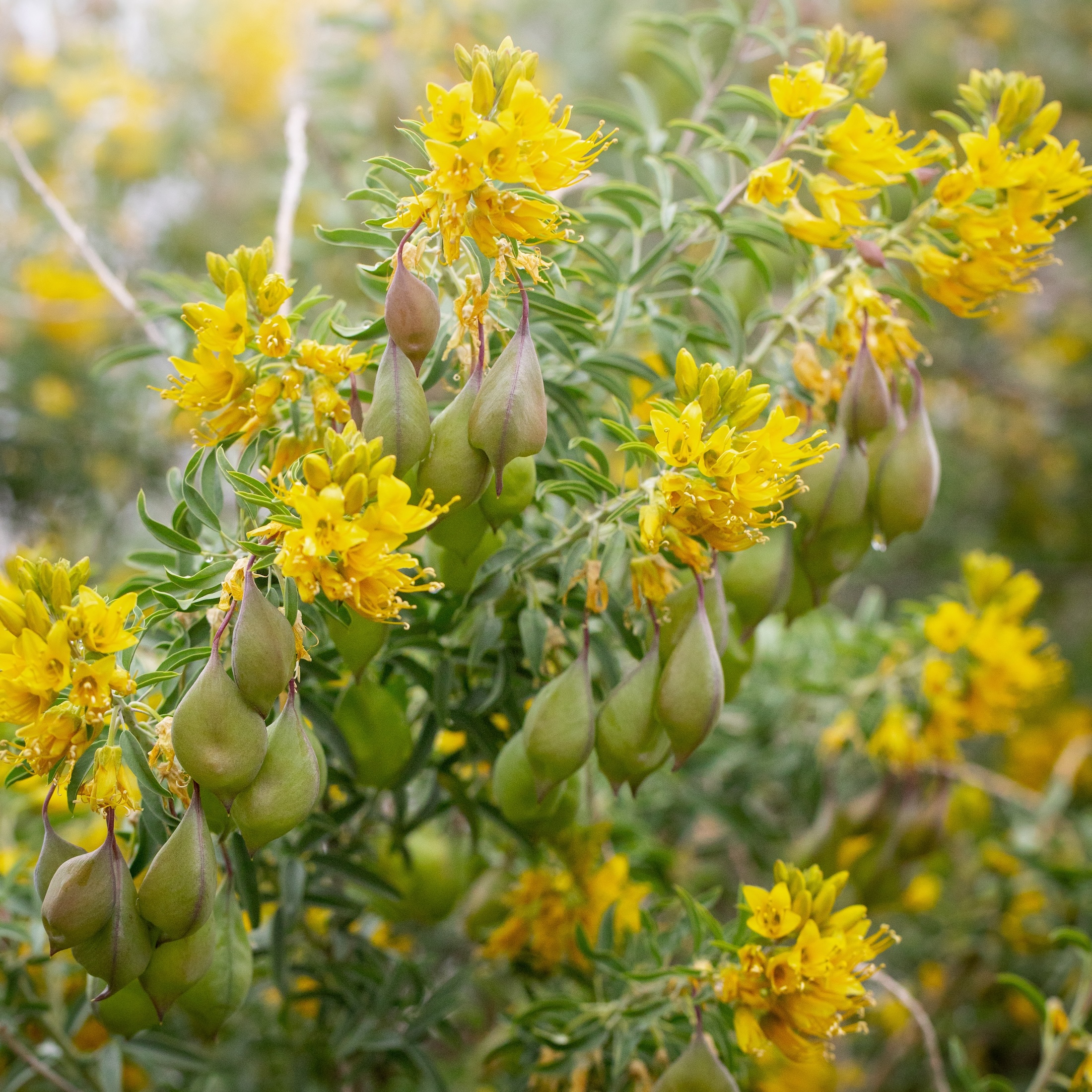
bladderpod
Peritoma arborea
This constantly blooming evergreen shrub stands out as a pollinator favorite, attracting beneficial insects and hummingbirds. The yellow flowers develop into attractive inflated seed pods, providing habitat value and visual interest. Native to southern California deserts, this species thrives with no summer irrigation in our region.
- ☀️: Sun
- 💧: Low irrigation
- 🌱: CA native plant
- 📏: 4 ft tall, 4 ft wide
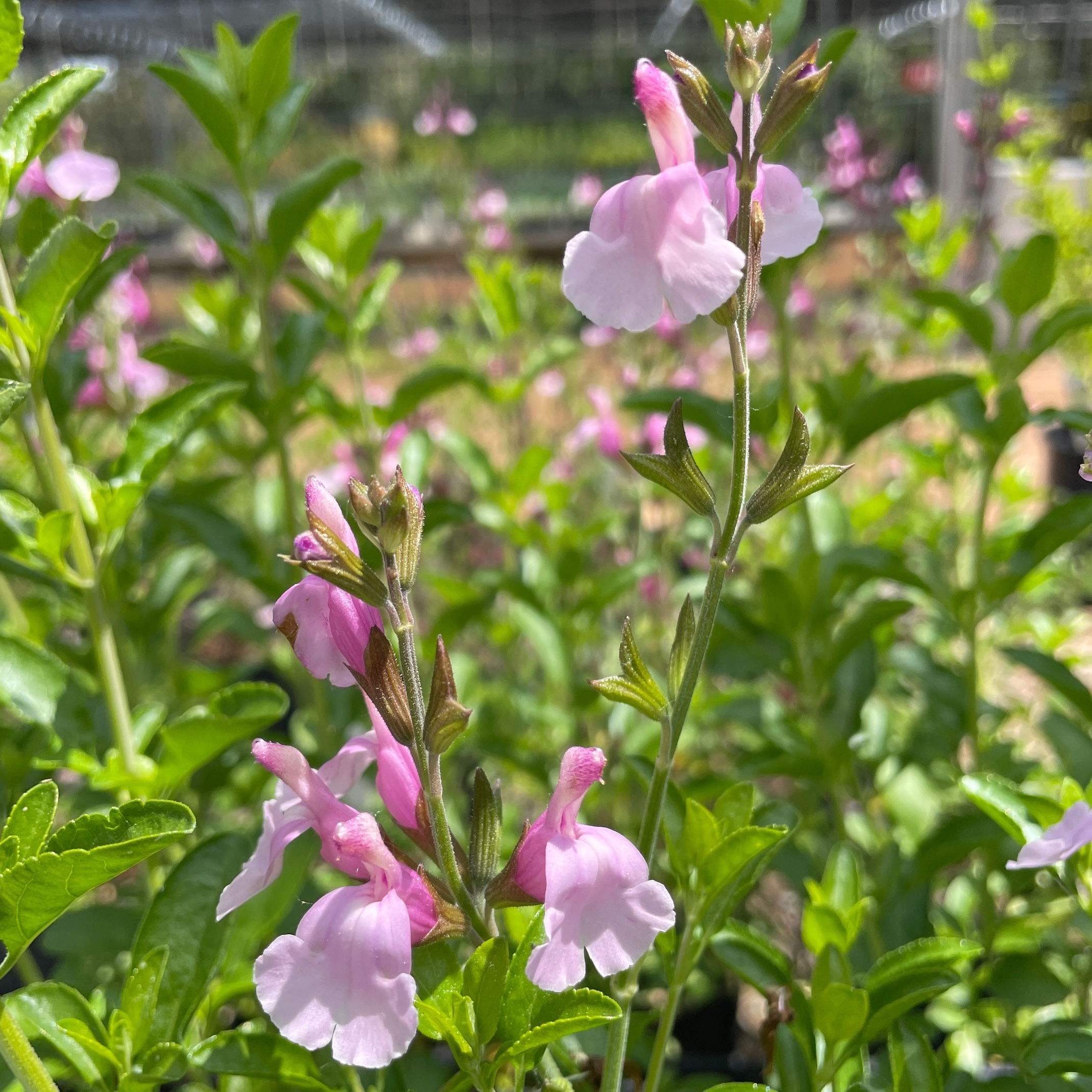
Gregg’s salvia
Salvia greggii (var.)
These easy-to-grow, long-blooming, semi-woody plants bloom prolifically in both spring and fall with many colorful flowers. Named forms like ‘Desert Blaze’, ‘Red Swing’, ‘Flame’ and ‘Hot Lips’ are tough and dependable in our area, where they are favorite nectar sources for hummingbirds and carpenter bees.
- ☀️: Sun
- 💧: Low irrigation
- 🌱: Southwest US native
- 📏: varies
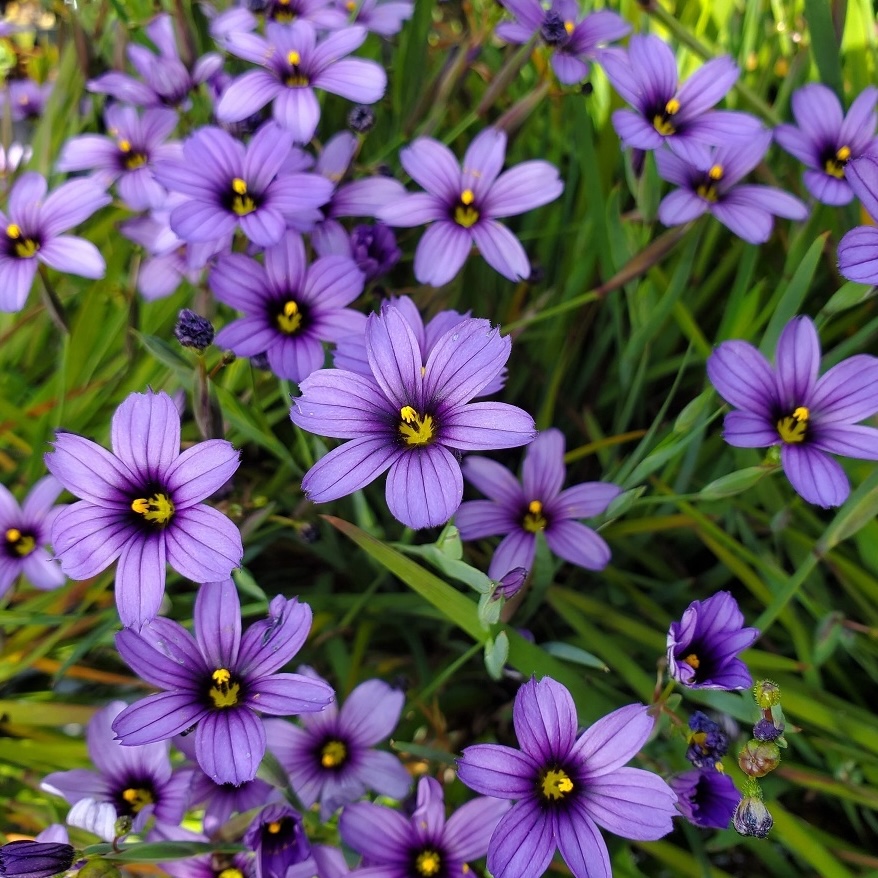
California blue-eyed grass
Sisyrinchium bellum
Not a true grass, but a cousin of the iris, this local native perennial attracts a diversity of insect pollinators with its star-shaped purple-blue flowers in spring. Thriving in full sun or part shade and adaptable to drought or regular watering, it provides a versatile option for sustainable gardens.
- ☀️/🌥️: Sun/part shade
- 💧: Low irrigation
- 🌱: CA native plant
- 📏: 1 ft tall, 2 ft wide
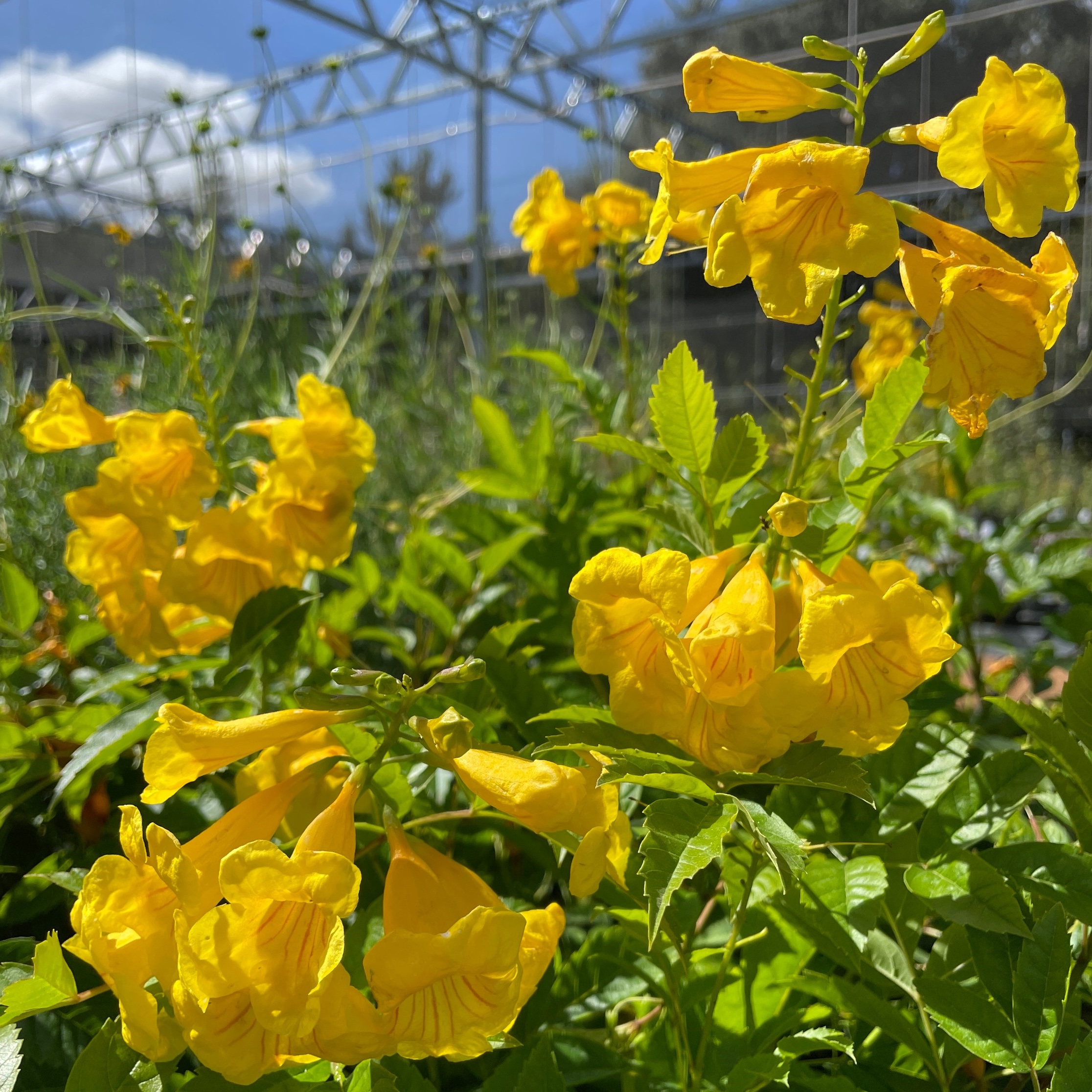
yellow bells
Tecoma stans
This semi-evergreen, heat- and drought-tolerant shrub adds a cheerful touch to sunny locations with trumpet-shaped yellow flowers all summer long. Its adaptability to various soils makes it a valuable addition to climate-ready gardens.
- ☀️: Sun
- 💧: Low irrigation
- 🌱: Southwest US native
- 📏: 6 ft tall, 4 ft wide
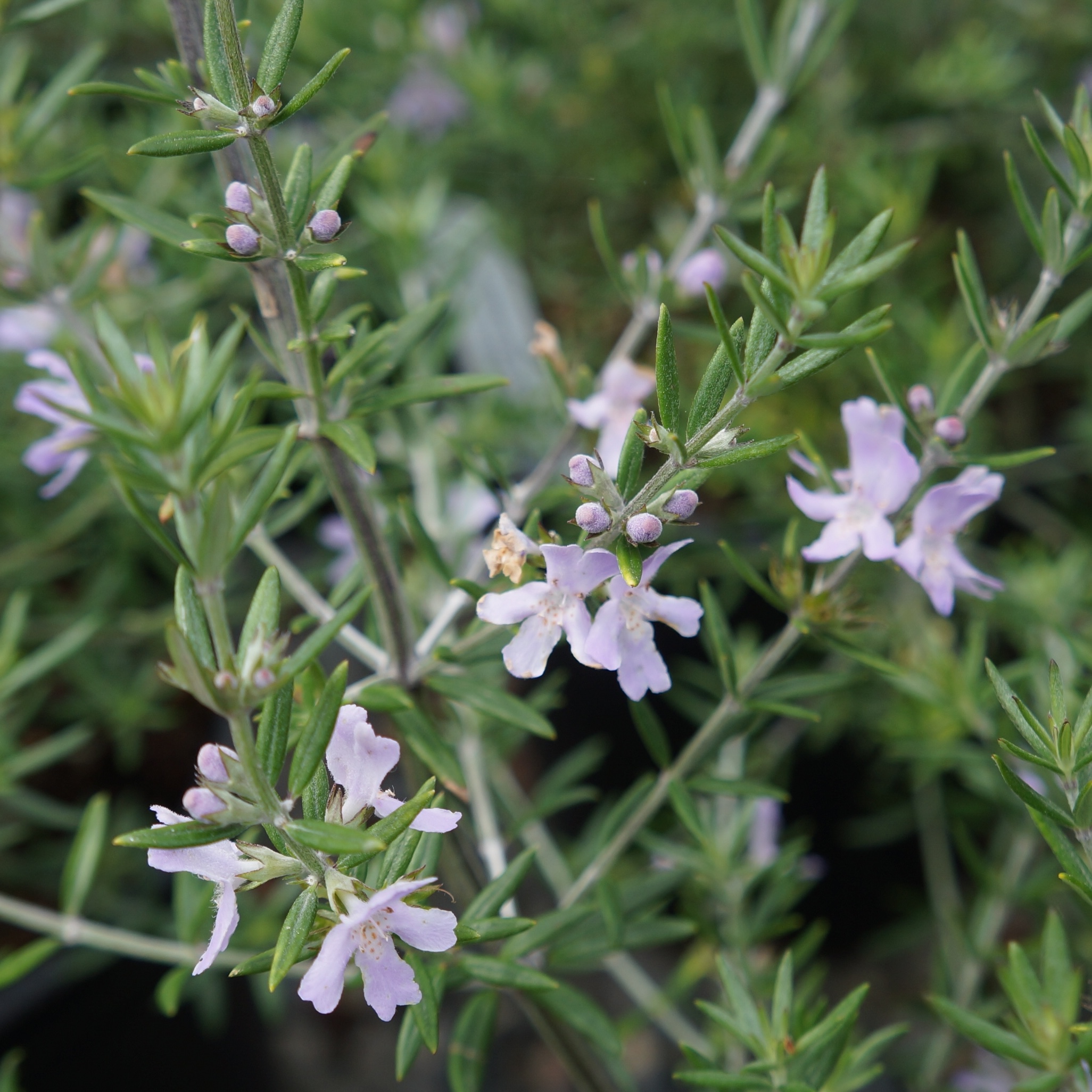
coast rosemary
Westringia fruticosa
With grayish leaves and constantly blooming small lavender or white flowers that are beloved by native bees, this low-water shrub adds both beauty and ecological richness to your garden. Its dependability and long life make this plant a sustainable choice for gardeners seeking to enhance the overall biodiversity of their outdoor spaces.
- ☀️: Sun
- 💧: Low irrigation
- 🌱: Australian native
- 📏: varies
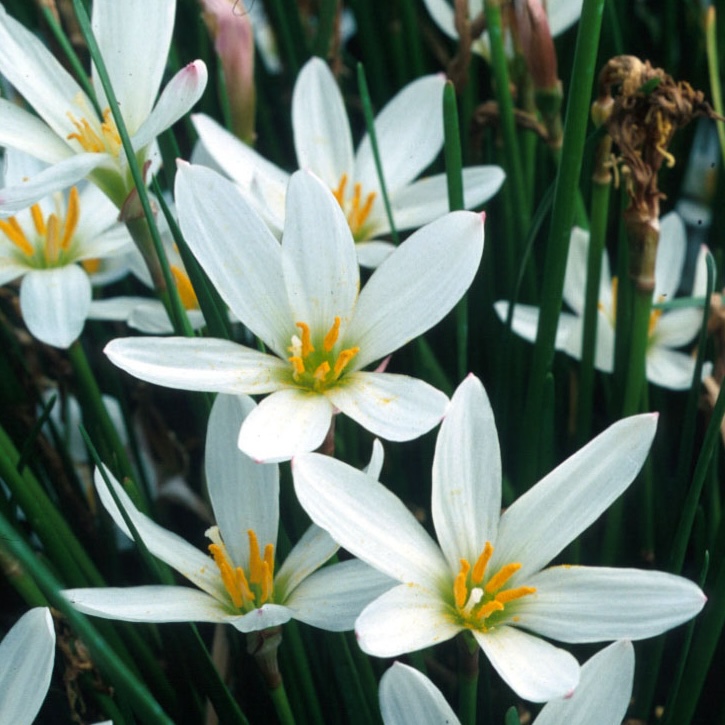
Argentine rain lily
Zephyranthes candida
Showcasing pure white flowers in the fall, this low-maintenance plant attracts beneficial insects while providing floral interest just as summer fades. Its versatility and ease of care make it a wonderful addition to various garden settings, contributing to the overall beauty and diversity of the landscape.
- 🌥️: Part shade
- 💧: Low irrigation
- 🌱: South American native
- 📏: 6-12 in tall, 6-12 in wide
